
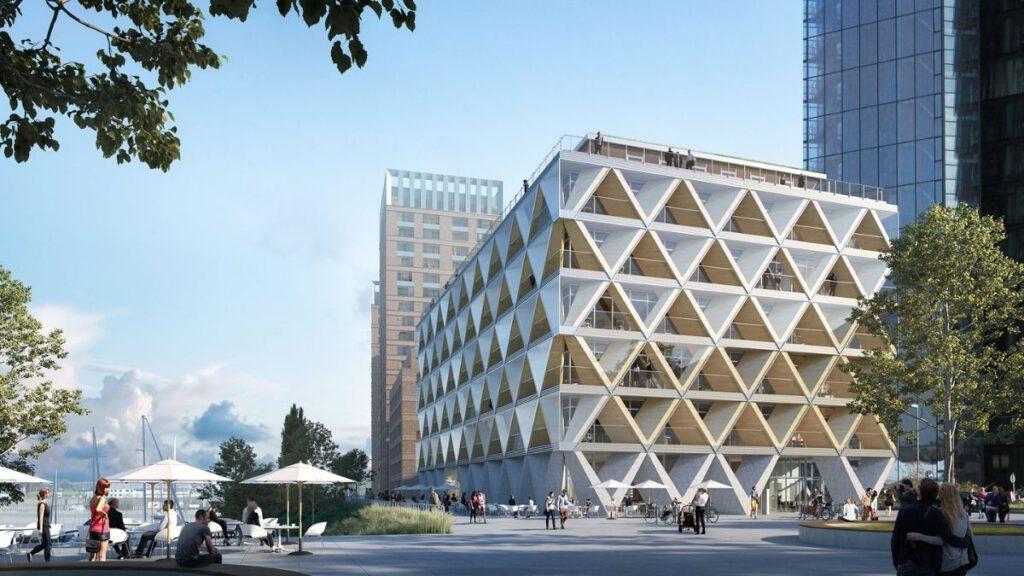
All in the name
In Düsseldorf, The Cradle is gradually taking shape. The timber hybrid office building is being constructed according to circular economy principles, and these will also govern its future use.
In Düsseldorf’s Media Harbour, The Cradle is gradually taking shape. The construction work for the first ever timber hybrid office building to grace the North Rhine-Westphalia state capital began in spring 2020. The following December, after ten months of work, the underground work on Düsseldorf’s first ever timber hybrid office building was completed on time.
Seven Olympic-size swimming pools
Soil properties and the enormous water pressure due to the nearby Rhine presented an unusual challenge, as developer Interboden reports: “The excavation is twelve metres deep and needs to withstand enormous pressure. So it must be extremely secure.” The building pit holds an estimated 17 million litres, which is roughly the equivalent of seven Olympic-size swimming pools.
Now it is time for the structural engineering team to set to work on Speditionstrasse. The building is scheduled for completion in the second half of 2022.
The name of the building says it all. As Gerhard G. Feldmeyer, managing partner of HPP Architekten, the firm responsible for designing The Cradle, explains: “Given the rising emissions, limited availability of resources and dwindling landfill options for hazardous waste, the circular economy principle is adopting an increasingly central role in our work”.
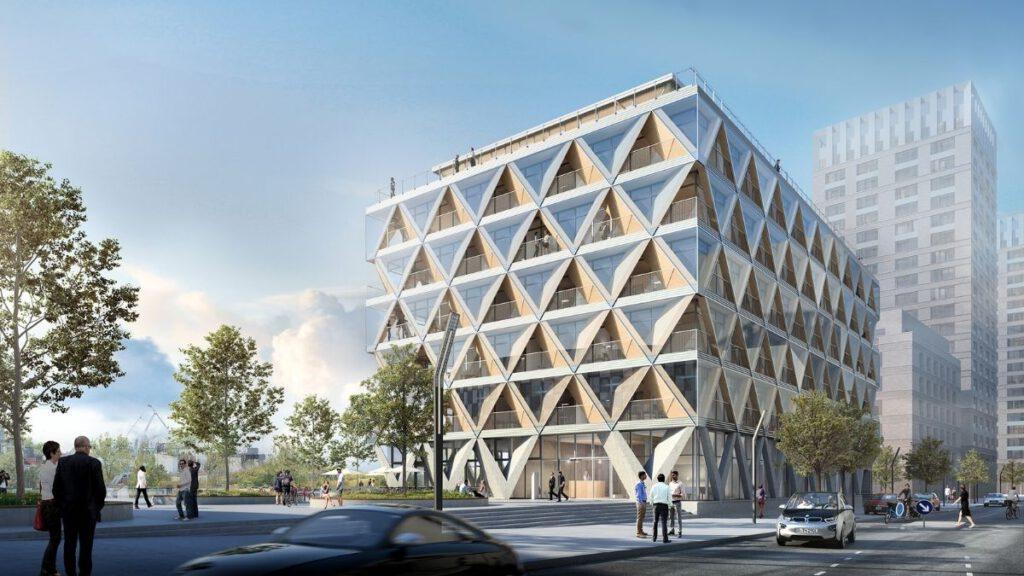
More and more C2C concepts in Europe
The term cradle is used to denote the origin of a building material. A widespread discussion about cradle-to-cradle concepts is already being held at European level, and the first projects adhering resolutely to this approach are already being implemented.
Feldmeyer: “The Cradle to Cradle® design concept is eco-effective and goes beyond conventional instruments and approaches, which are primarily concerned with merely minimizing negative influences. Cradle to Cradle® takes into account economic, ecological and social aspects in equal measure.”
Not just about materials
Ideally, materials are used in such a way that, once they reach the end of their useful life, they can serve as raw materials in biological or technical cycles, constantly circulating as nutrients as they would in nature.
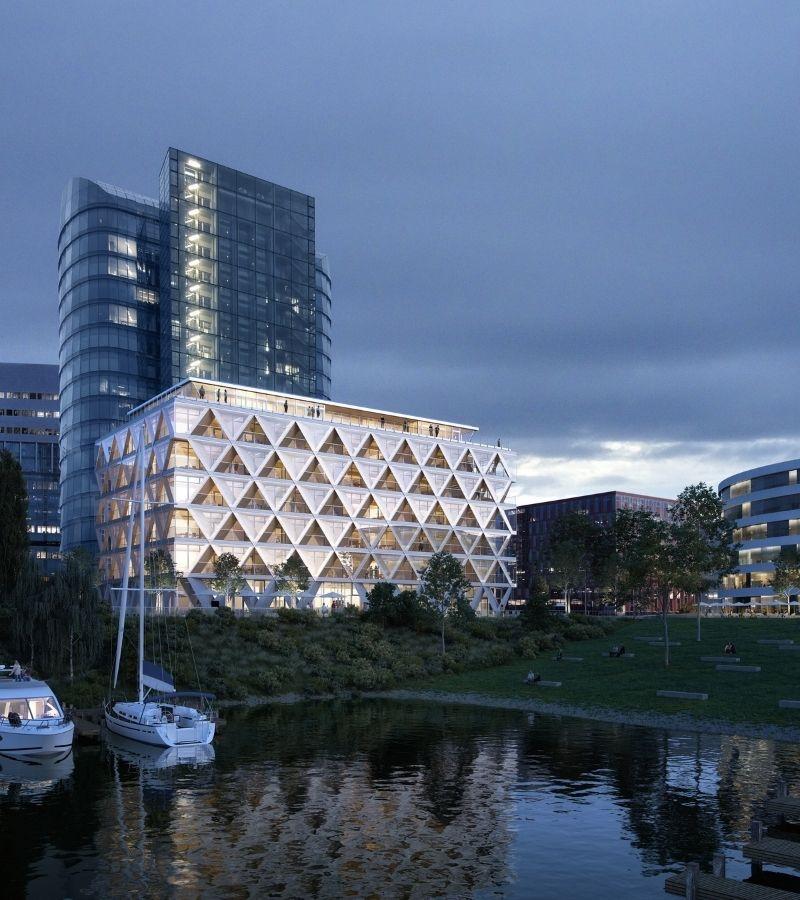
“The important thing is to take a holistic view that includes not only the materials themselves but also aspects like material composites or transport routes,” explains Carsten Boell, managing director of Interboden Innovative Gewerbewelten, which is part of the Interboden Group, a family-run group with almost 70 years’ experience in residential and commercial construction as well as in planning, architecture and property management.
Material passport
With The Cradle, all materials used can be traced via a “material passport”, which determines their exact type, service life and position. This material passport is also linked with the BIM model (Building Information Modelling) used for The Cradle.
If materials have to be transported from the other side of the world or material composites contain toxic substances, the project can’t claim to be sustainable – even if the building itself is entirely CO2-neutral.
Carsten Boell, managing director of Interboden Innovative Gewerbewelten
The Cradle as a timber hybrid
The Cradle is being developed using a unique timber hybrid construction. For the most part, the building consists of wood, which will be visible especially on the façade and the ceilings. The renewable material is felt to symbolize the concepts of sustainability and circular economy. Wood is healthy, binds CO2 and has a positive effect on the indoor climate.
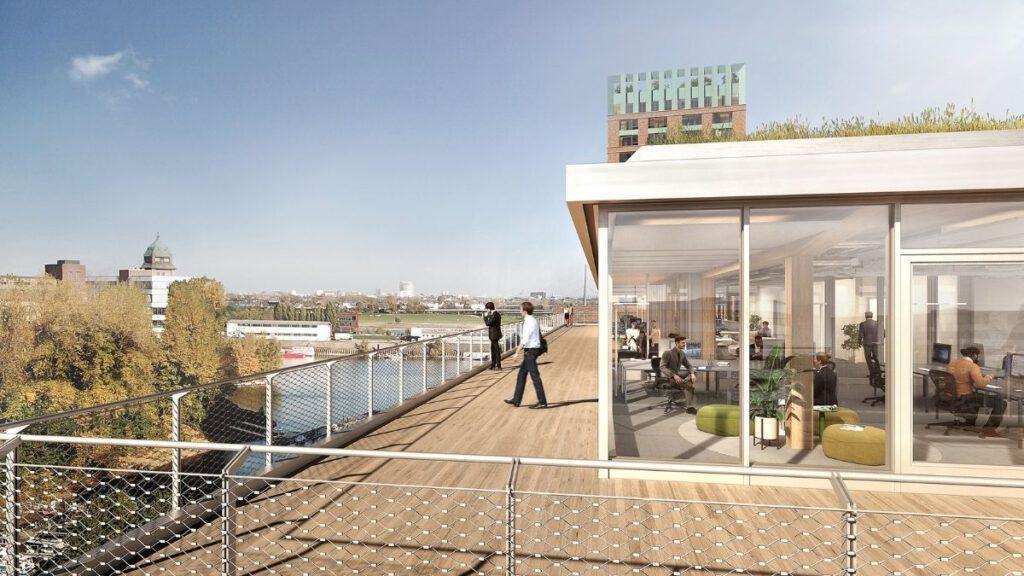
Factoring in the entire construction and usage phase, one third less CO2 is produced by The Cradle compared with conventional buildings. The detached building will have around 5,200 m² of floor space together with an area of 600 m² for waterside restaurants and cafés.
Safe recycling of materials
The rhombic timber façade is not just a support structure: its openings also provide shade and enhance the natural ventilation. It is designed with inserted joints rather than composites and adhesive joints.
Boell: “This systematic approach benefits both the environment and the people who will eventually work in the building.” Apart from the “banned list”, a number of substances have been ruled out owing to hazardous properties relating to their production, usage and disposal.
This ensures that none of these constituents will be used in products, posing a health risk for the building or its users. At a later stage, these can be recycled safely in keeping with circular economy principles.
Valuable store of raw materials
Together with an interdisciplinary team, Interboden is planning The Cradle as a valuable store of raw materials. As the price of construction materials is being pushed up by the growing raw material shortage, the building’s residual value will increase over time.
The aforementioned material passport acts as a kind of digitalized materials catalogue showing their recyclability, health category, pollutant content, separability and CO2 consumption.
Design for dismantling
Feldmeyer: “The recyclability and separability – design for dismantling – of materials and products is becoming an increasingly central aspect of our work. This means that building elements can be reused after their initial service life. Here, the interdisciplinary team made up of project developers, architects, technical planners and cradle-to-cradle consultant EPEA pool their ideas in a kind of future lab.”
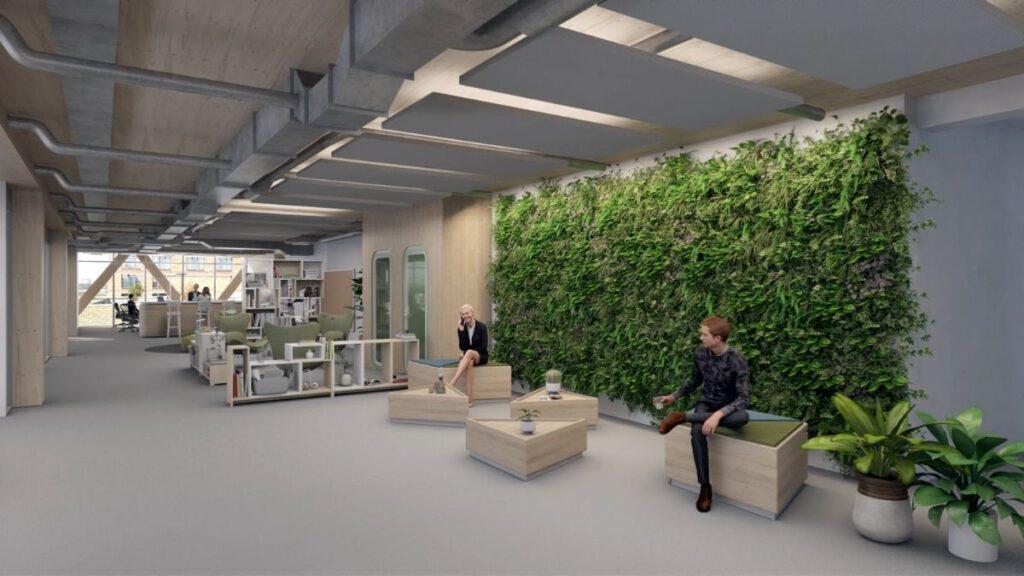
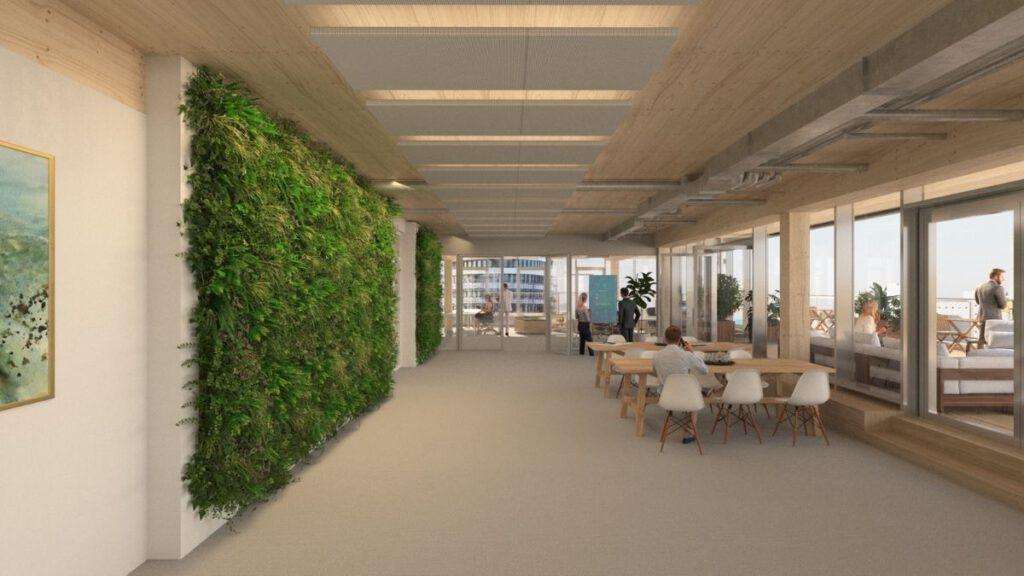
Pre-letting to co-working provider
Six months before planning permission was even granted, half of the office space had already been pre-let to a number of tenants, including leading co-working provider Spaces. On four floors, conventional and flexible office space is available for start-ups or for established companies and their staff and project teams.
Spaces offers a combination of private offices, business club, open workspaces and meeting/seminar rooms. It also provides numerous services such as bicycle hire, technical support and food services. Comfort, flexibility and networking are its core areas of focus.
Service app
Fittingly, Interboden will be using a service app for The Cradle to provide the flexibility that modern office users need as regards time, space and organization.
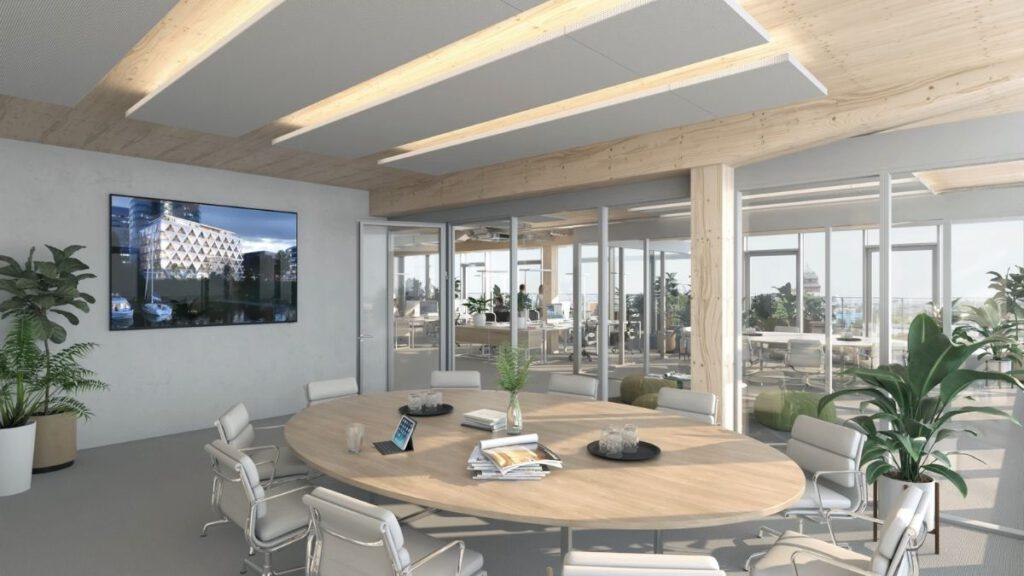
CSR increasingly important for users
Sustainability is becoming part of company strategies and culture. Carsten Boell has no doubt that this trend will continue to grow. It will bring about a change in the needs and expectations of companies who want office properties to convey their own corporate philosophy and fit with their values.
Boell: “Corporate Social Responsibility is a growing priority for all companies. It is something that is expected more and more frequently not only by their own workforce, but also by their customers and business partners.” From a project development perspective, this means taking all factors on board at the planning stage.
Knowledge gaps among the general public
However, the public at large is less well informed about CSR. “There’s a bit of catching up to do,” confirms Boell. However, exploring and discussing the issue leads to knowledge being shared and transferred. As well as this, it is being regulated and simplified in practice.
“It is an admirable opportunity for the real estate sector to push the circular economy agenda and to be instrumental in shaping it. Even within the sector itself, information is still thin on the ground.” What is really needed are practical and “tangible” examples of recyclable construction.
Text: Linda Benkö
Translation: Rosemary Bridger-Lippe
Renderings: INTERBODEN / HPP / bloomimages
Other articles
that might interest you
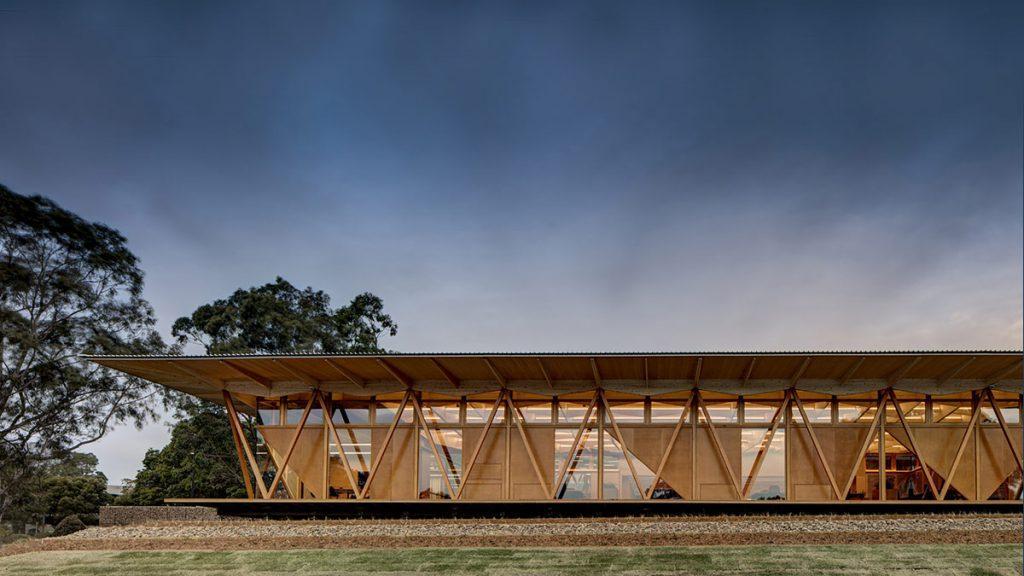
Australia could be described as a late mover as far as sustainable construction is concerned. One of its timber buildings – the award-winning Macquarie University Incubator – shows how to reduce energy and resources on all levels.
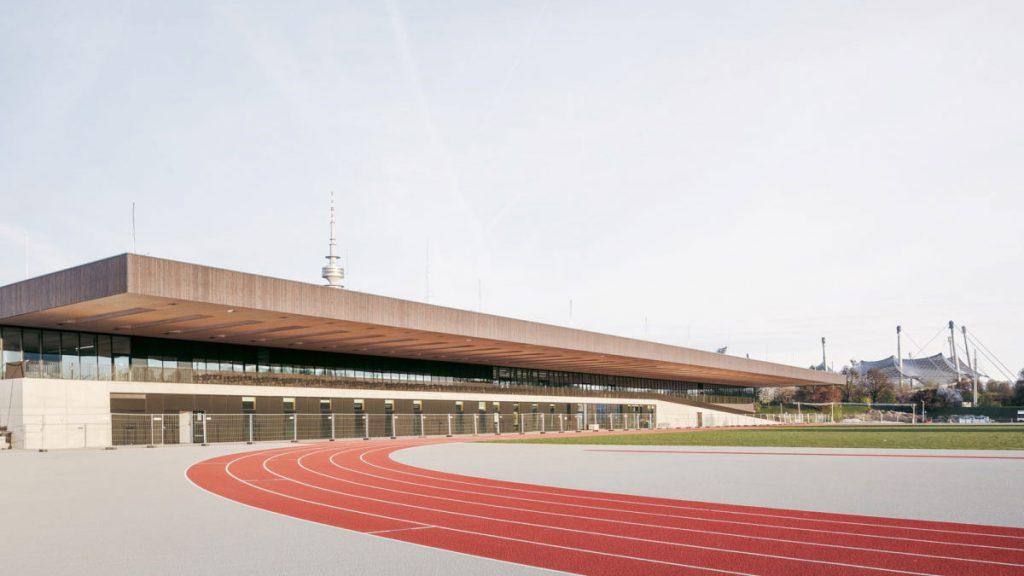
The TUM Campus at Munich’s Olympiapark shows how a carefully planned timber project can save resources and the associated costs. Shortlisted for the DAM Preis 2024, it was formerly Europe’s largest timber construction.
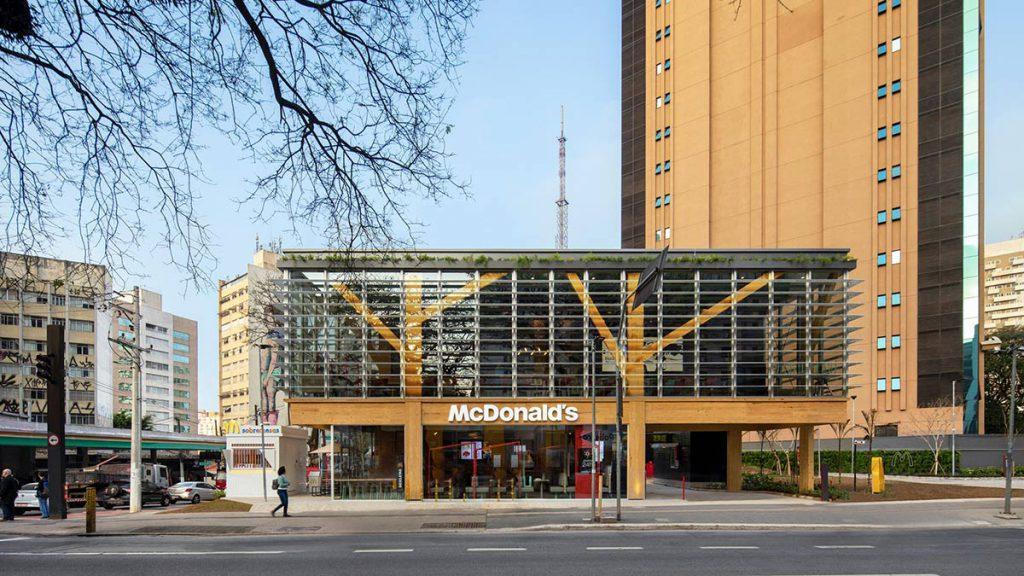
São Paulo is home to Brazil’s “most sustainable McDonald’s”. It has a timber design and is presented as an educational project for sustainable building. For the company, the wooden structure is a “recipe for the future”.
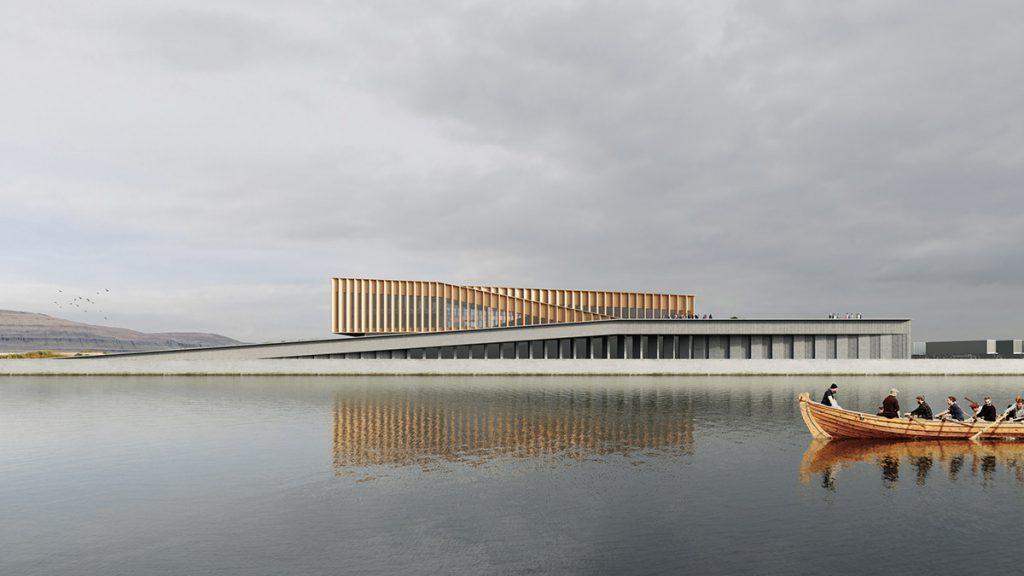
The new Torshavn ferry terminal is set to give the Faroe Islands a new architectural landmark with a hybrid timber-concrete design. With architects Henning Larsen on board, it also re-opens the harbour to the islanders.
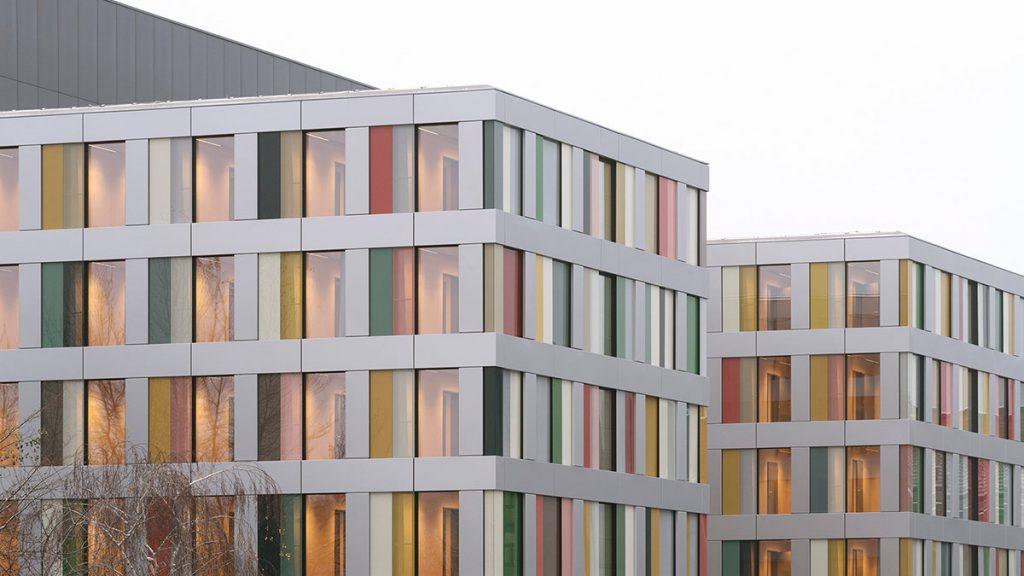
For its new office building Luisenblock West, the German Bundestag chose a design using prefabricated wooden modules. Austrian module experts Kaufmann Bausysteme have been working flat out ever since. On hotels, schools and student halls.
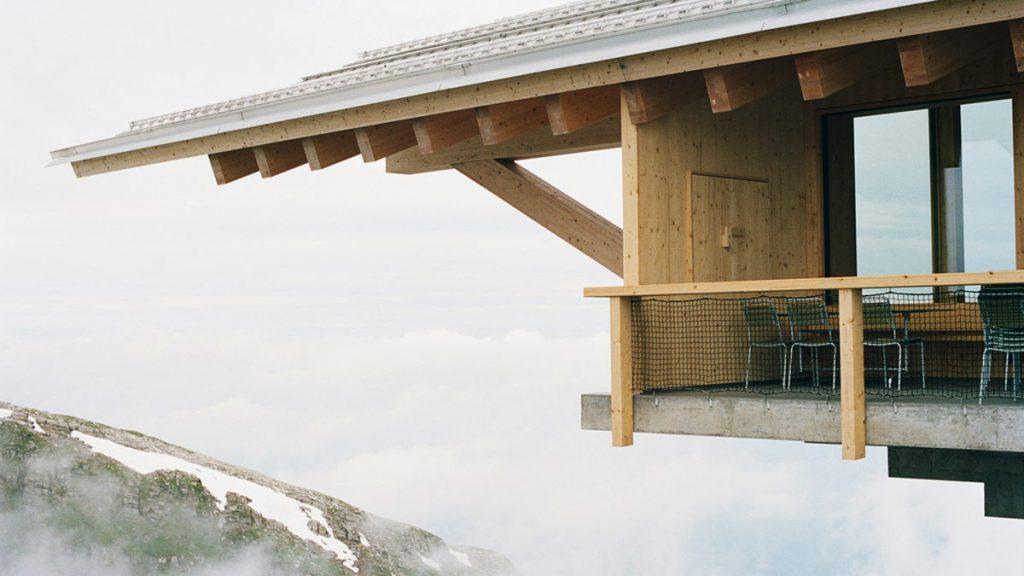
Anybody looking to combine a skiing trip with some architectural gems will be in their element at the top of the Chäserrugg in Switzerland. A tour of this award-winning building designed by Herzog & de Meuron gives an insight into sustainable construction methods at a height of 2,262 metres.
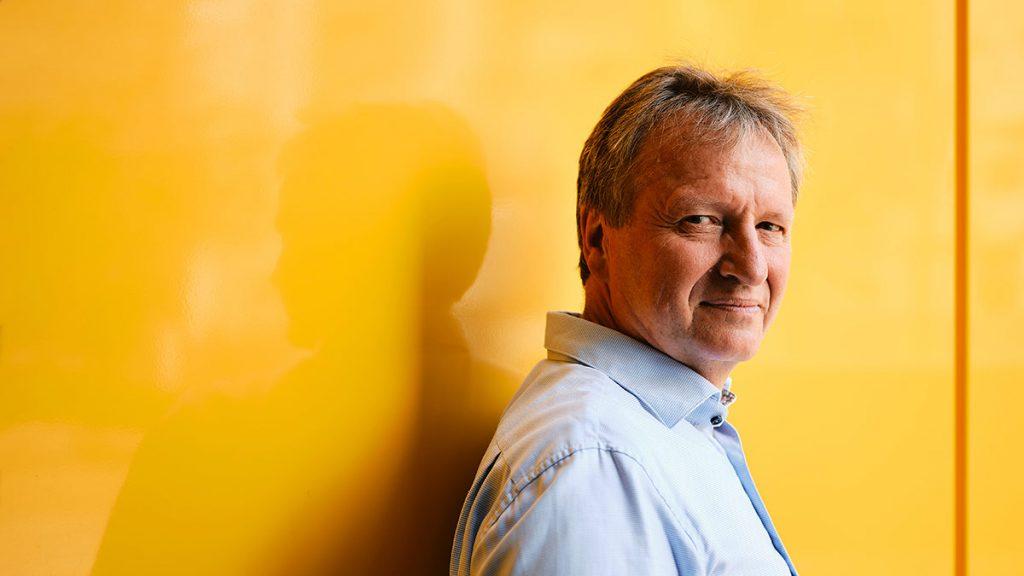
Stefan Winter ranks among the leading experts on the use of wood as a building material. In an interview with UBM Development, the professor and trained carpenter explains why hybrid solutions are not a step backwards for timber construction and how long-lasting timber products can help to mitigate climate change.
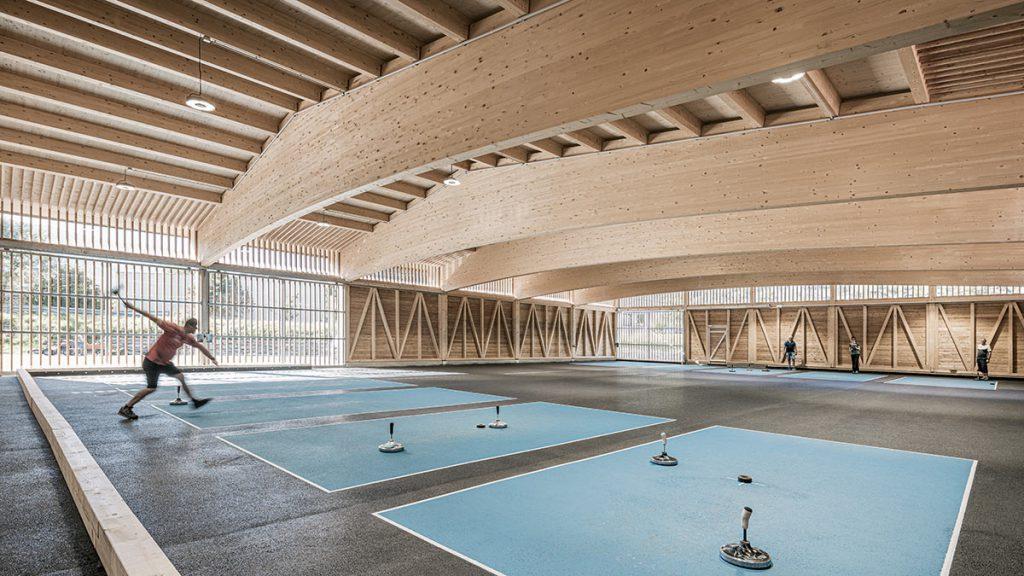
Shortly after Lungau Arena opened its doors, it was singled out as an ambassador for exemplary and sustainable timber construction. This new sports facility goes far beyond economic and functional requirements.
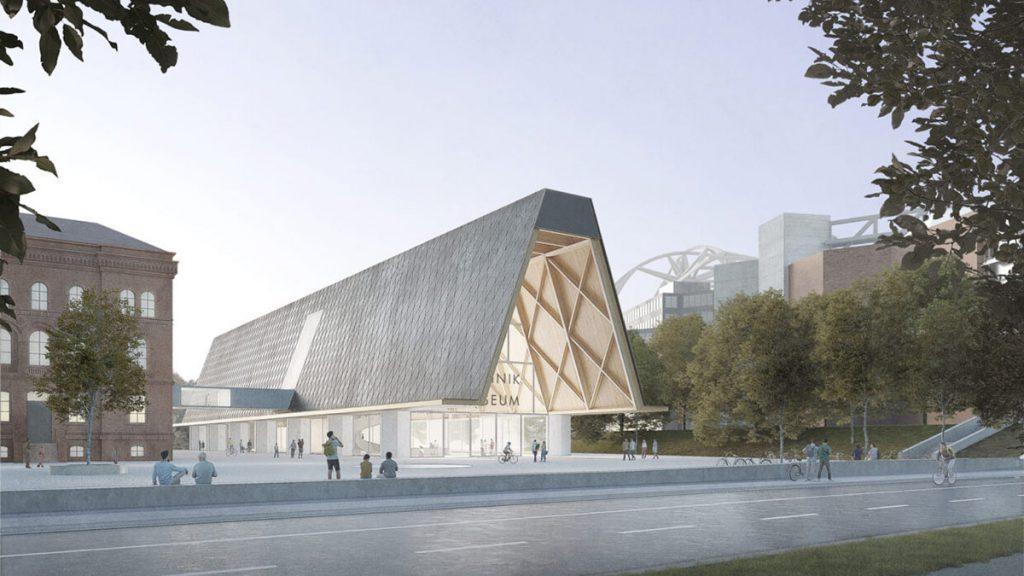
A new entrance building has been designed for the Deutsches Technikmuseum in Berlin. With its striking lattice roof, the design by Austrian architectural firm Innauer Matt demonstrates that modern timber construction is a byword for progress through sustainability.
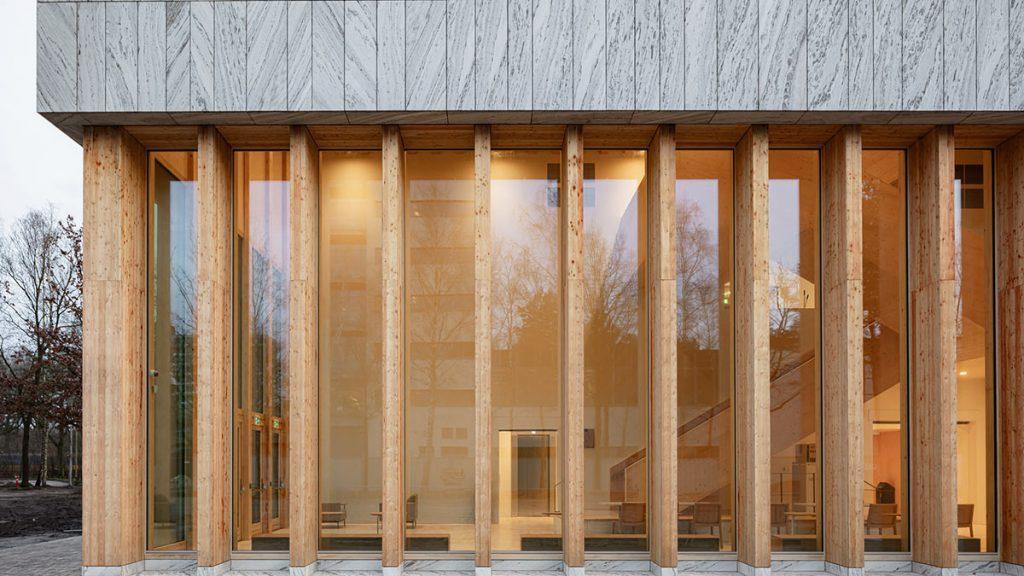
The Marga Klompé Building at Tilburg University is the first academic building in the Netherlands to be built out of wood. Insulation made from recycled denim jeans is part of the circular design by Powerhouse Company.
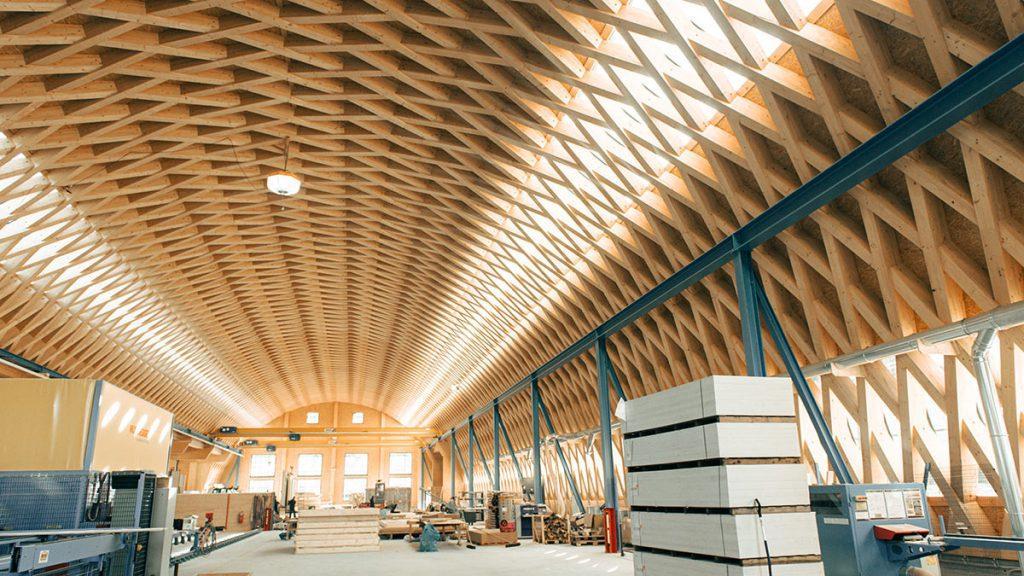
One hundred years after patenting of the Zollinger roof, this self-supporting timber structure is experiencing a renaissance. Designed to save materials, recyclable and easy to build, it has regained popularity for the construction of today’s factory workshops.
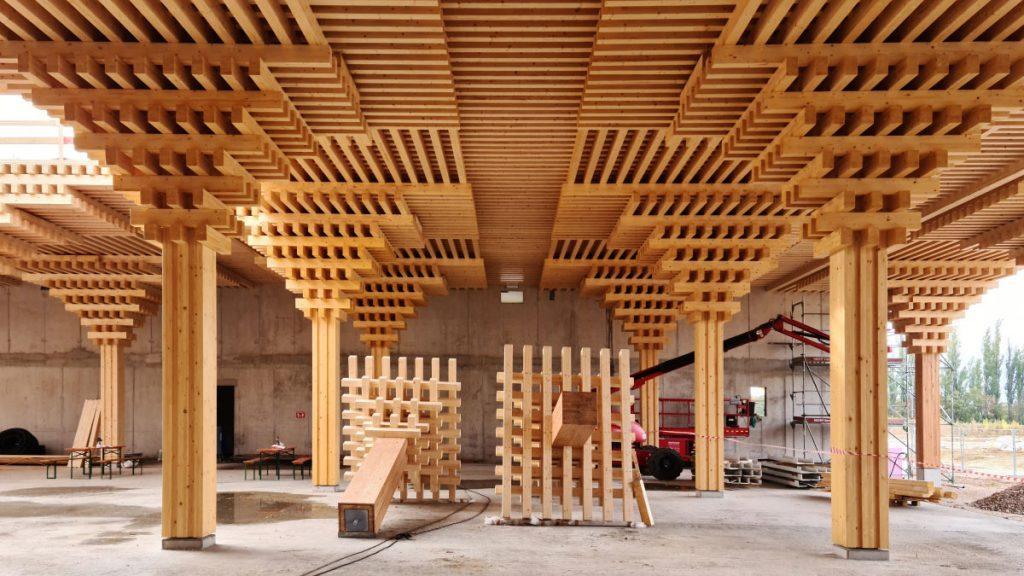
A supermarket designed as a net-zero construction that produces its own food for the region. This is the concept behind Rewe Green Farming and its prototype in Wiesbaden, Germany. Timber engineering is central to the company’s plan for similar stores.
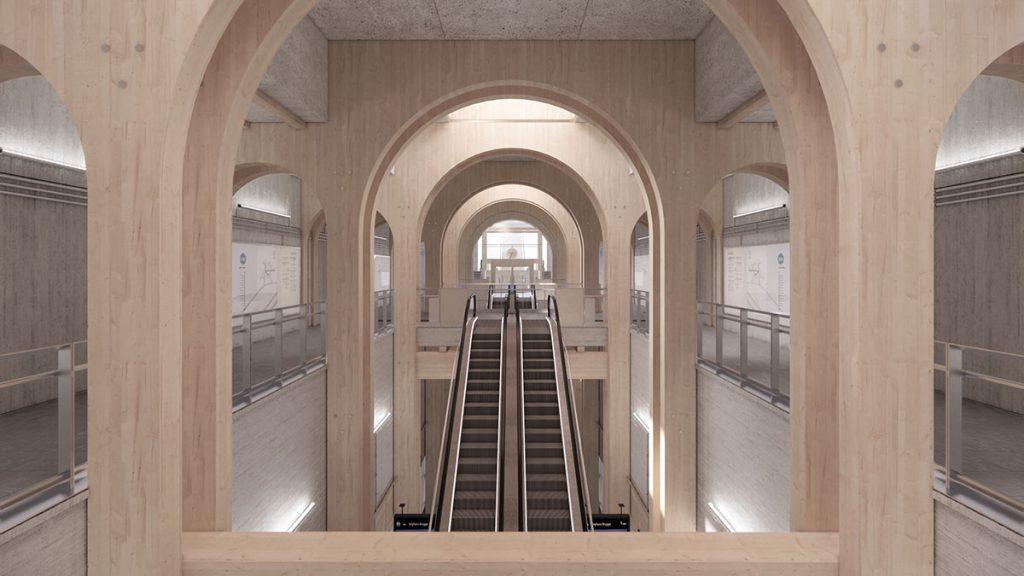
Although this design looks like a utopian dream, in Copenhagen it is set to become reality. Over the coming years, the Danish capital will be introducing timber-hybrid metro stations. The concept by JaJa Architects adopts a holistic approach and takes climate-friendly building below ground.
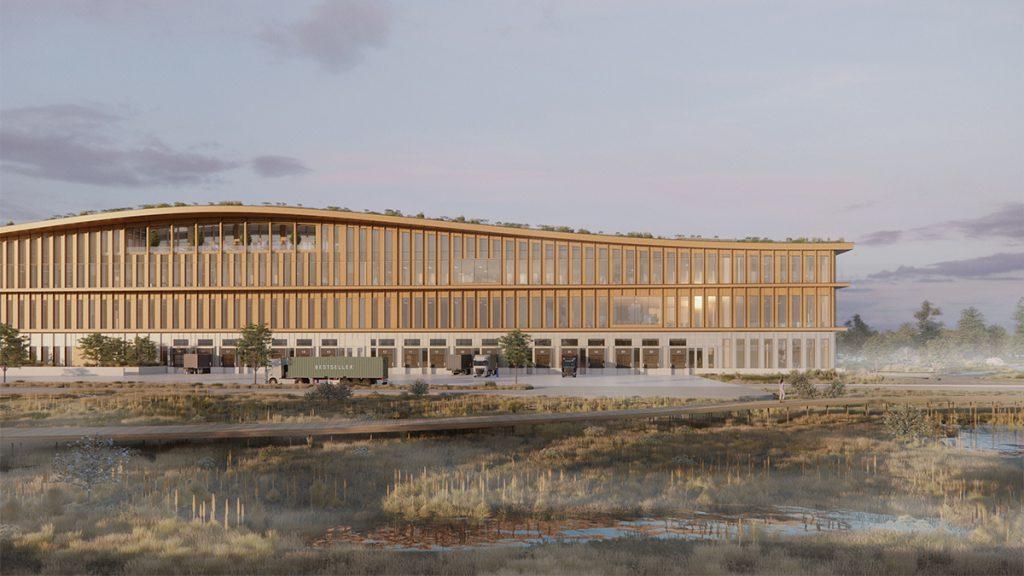
Not far from Amsterdam, fashion giant Bestseller is building Europe’s largest timber logistics centre – called “Logistics Center West”. Designed by Danish architects Henning Larsen, it aims to set new standards in sustainability and design.
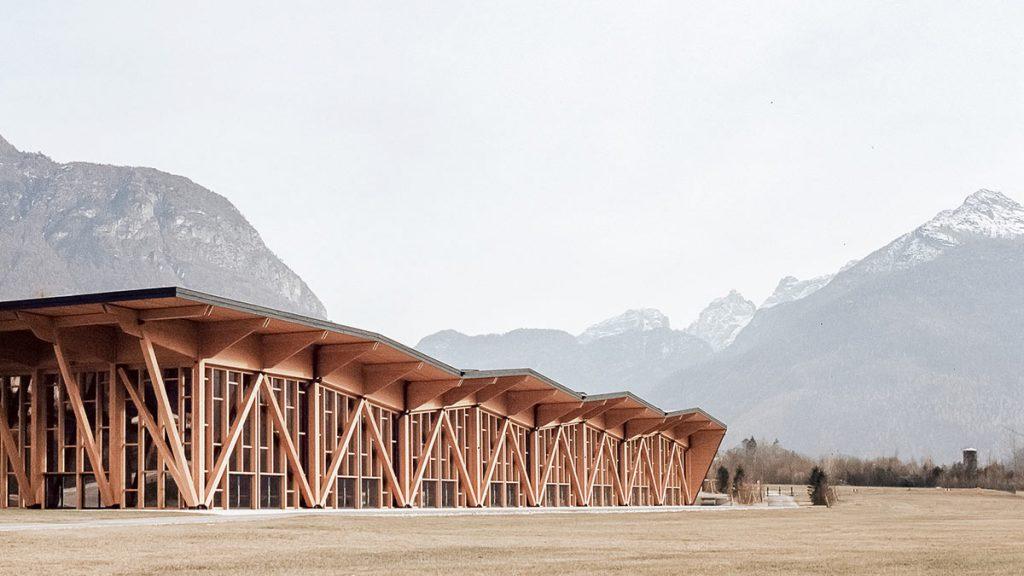
Its design blends alpine architecture with the outline of a craggy mountain range. The Congress and Exhibition Centre in the municipality of Agordo in northern Italy reimagines aesthetic forms of expression in timber construction.
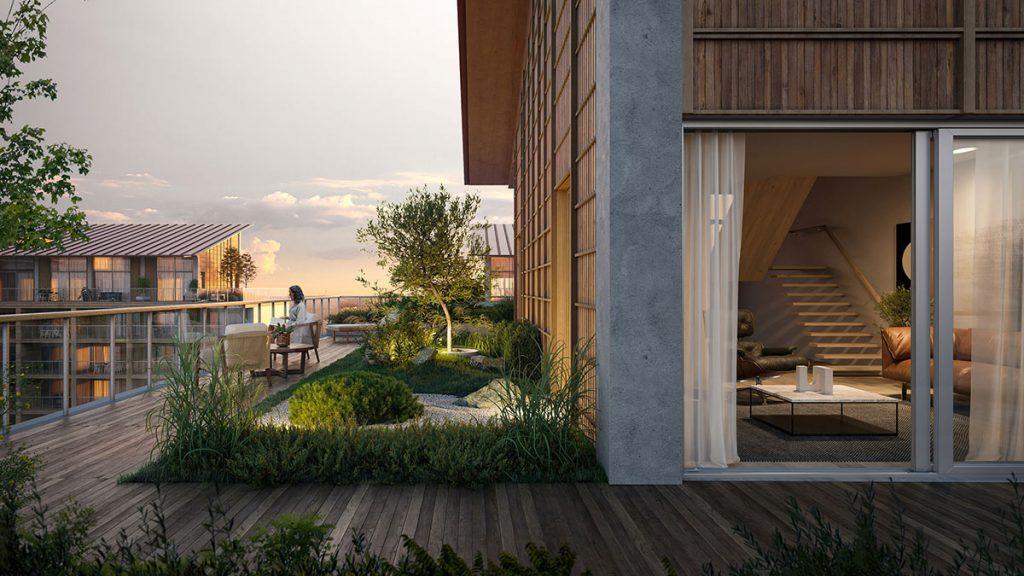
The Belgian city of Antwerp will soon benefit from a Japanese-inspired, timber-hybrid residential tower that is currently under construction. The building was designed by Pritzker Prize winner Shigeru Ban, who takes nature and wood as central inspiration for his designs.
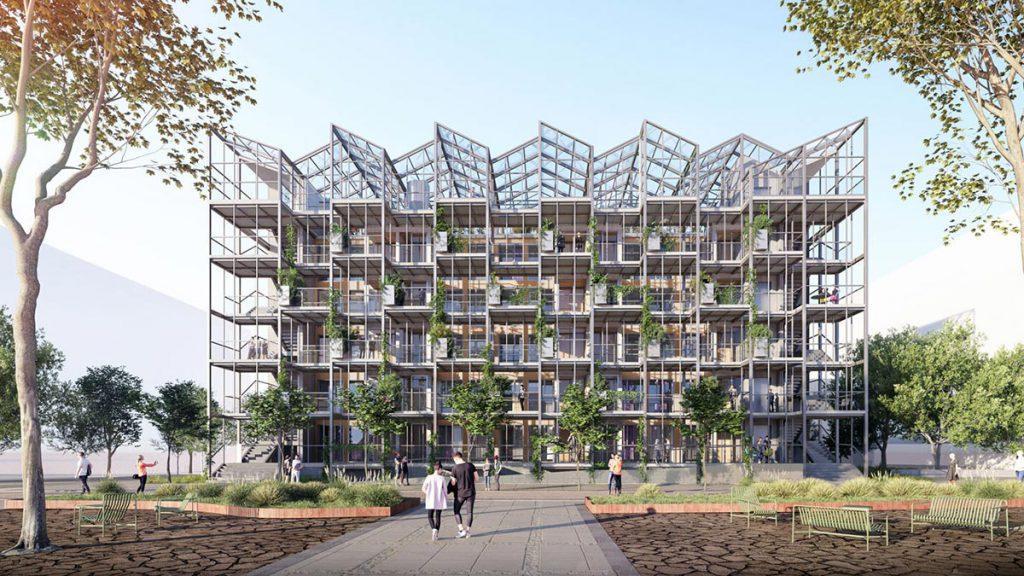
Bremen’s Überseeinsel district is a new, green neighbourhood currently under development. Affordable, sustainable and attractive living space will be on offer in the Residential Greenhouse. It is designed to be a home for both people and plants.
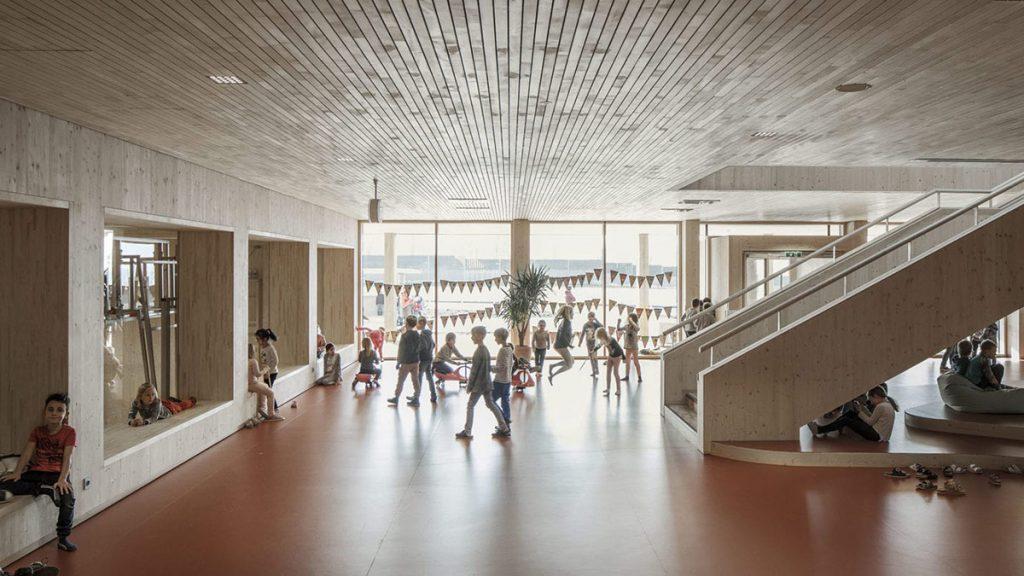
There is a severe shortage of schools – 15,000 are needed in Europe alone. The easy-to-assemble kit from Stora Enso – called Sylva – can be used to create eco-friendly wooden schools that offer children a positive learning environment and architecture that gives them a sense of meaning and purpose.
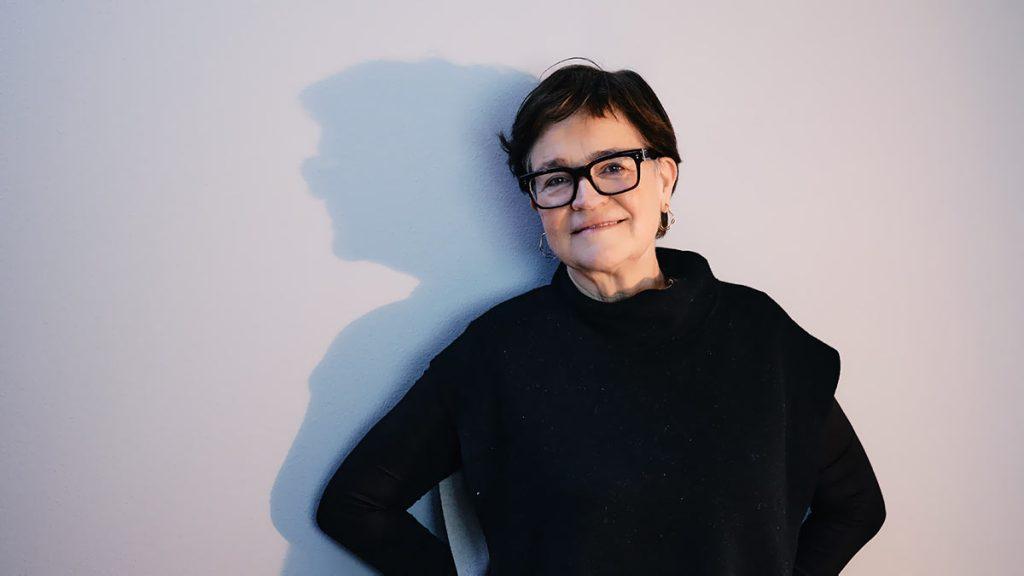
CEO Mette Kynne Frandsen has worked for over 20 years to make Danish architectural firm Henning Larsen what it is today: a pioneer in creating sustainable yet iconic architecture around the world. She gave us an interview before leaving her position.
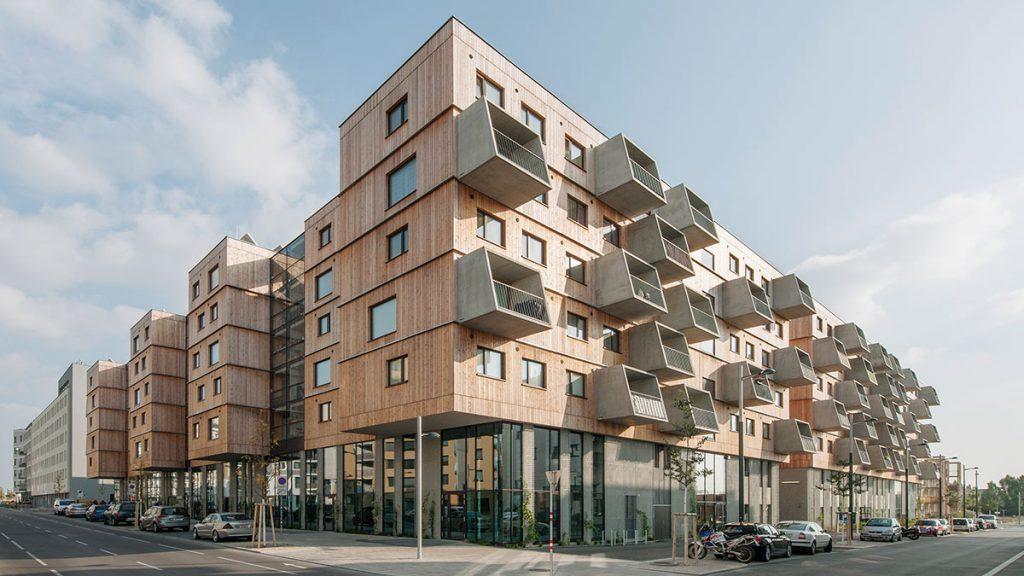
Climate change and social issues are closely intertwined, and climate-friendly timber construction is often still classed as a luxury segment. The timber housing project Seestadt Aspern in Vienna is an award-winning example of social housing construction, and also an Instagram hotspot.
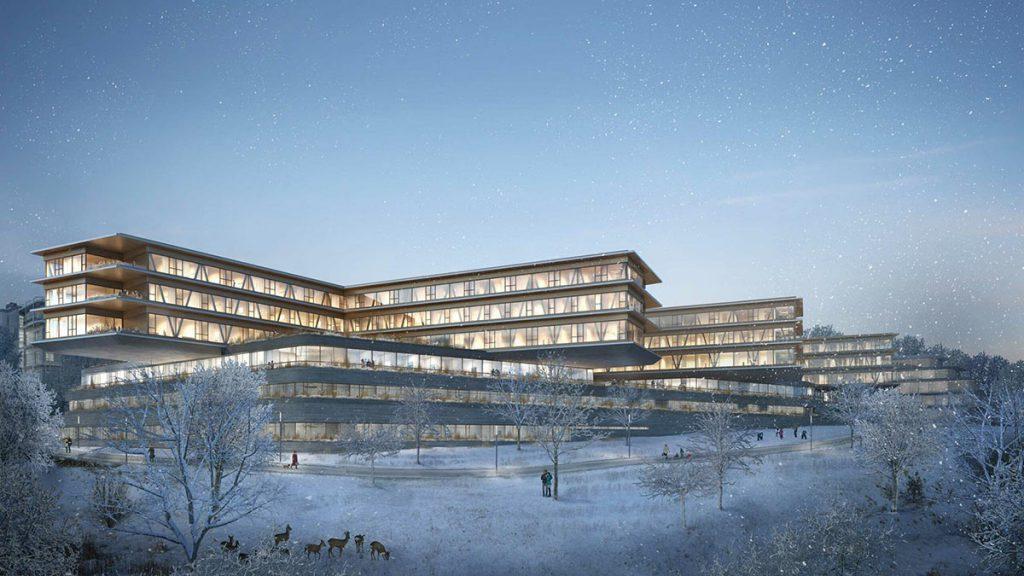
The New Medical Clinic (NMK) in Tübingen combines Scandinavian timber construction expertise with architecture that puts people first. Its wholly sustainable concept was designed by White Arkitekter and HPP Architekten.
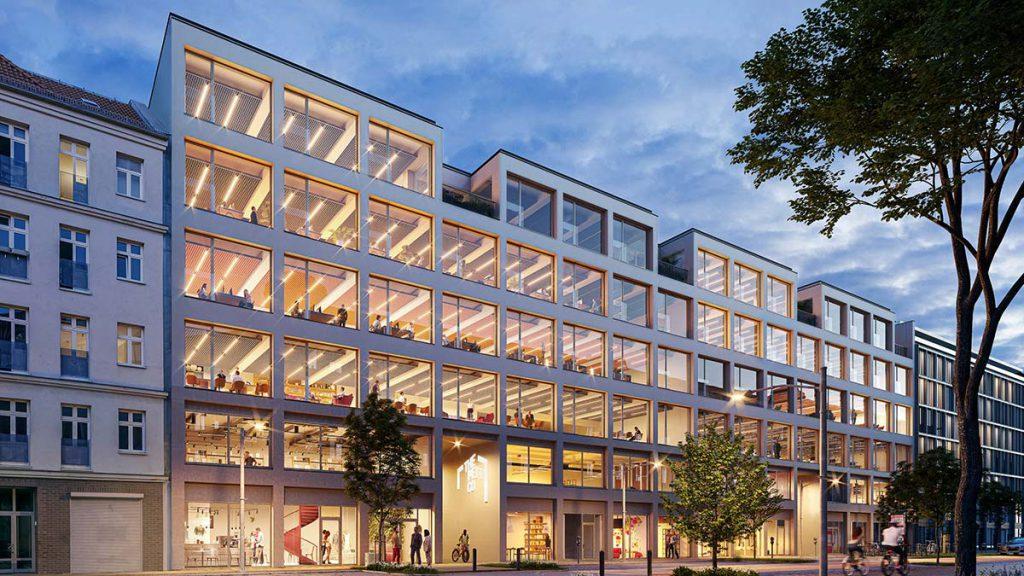
The PettCo is the name of a new neighbourhood development in Friedrichshain, Berlin, where Wilhelminian-style buildings are being renovated and made climate-ready, together with a sustainable new building. Six inner courtyards will provide new public space, urban farming included.
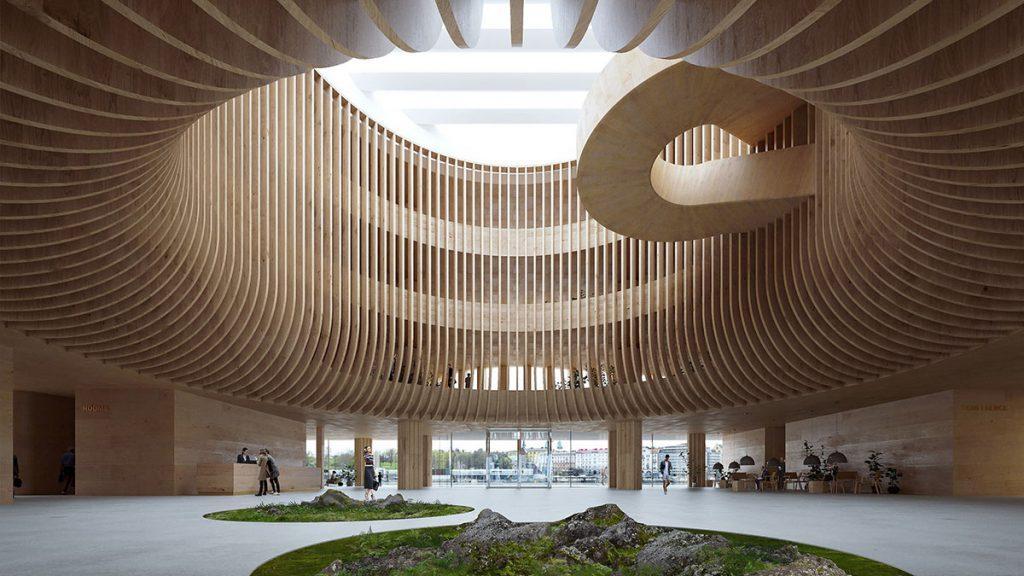
Stora Enso, the second largest forestry company in the world, will soon move into their new headquarters. The Katajanokan Laituri complex is set to be both a masterpiece of Finnish timber construction – and also climate neutral. Its aesthetics are reminiscent of grandmaster Alvar Aalto.
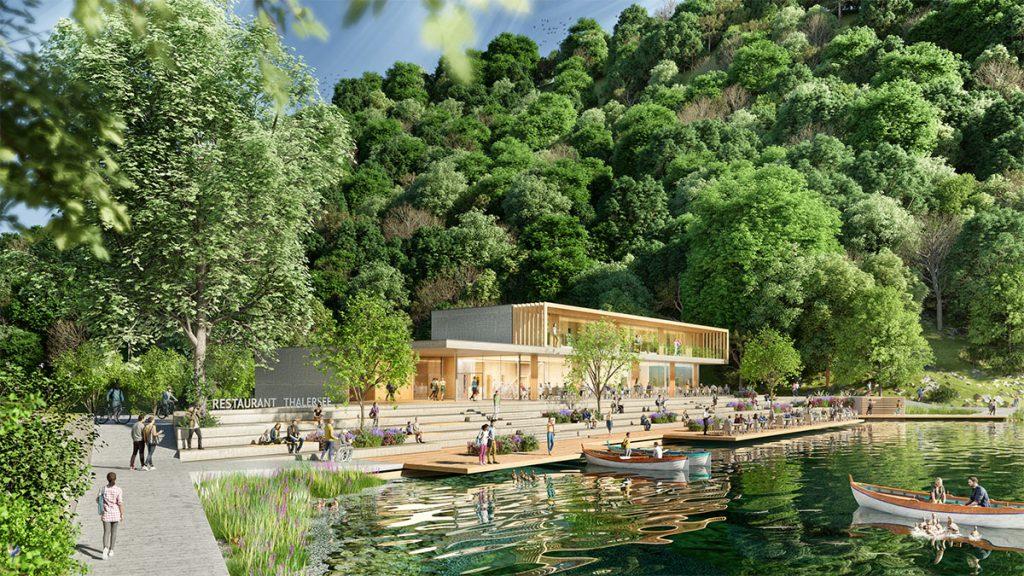
Architectural firm Pittino & Ortner based in Styria, Austria, is making a name for itself on two fronts: with its huge timber-hybrid book storage facility in Vienna and its café on Lake Thalersee near Graz.
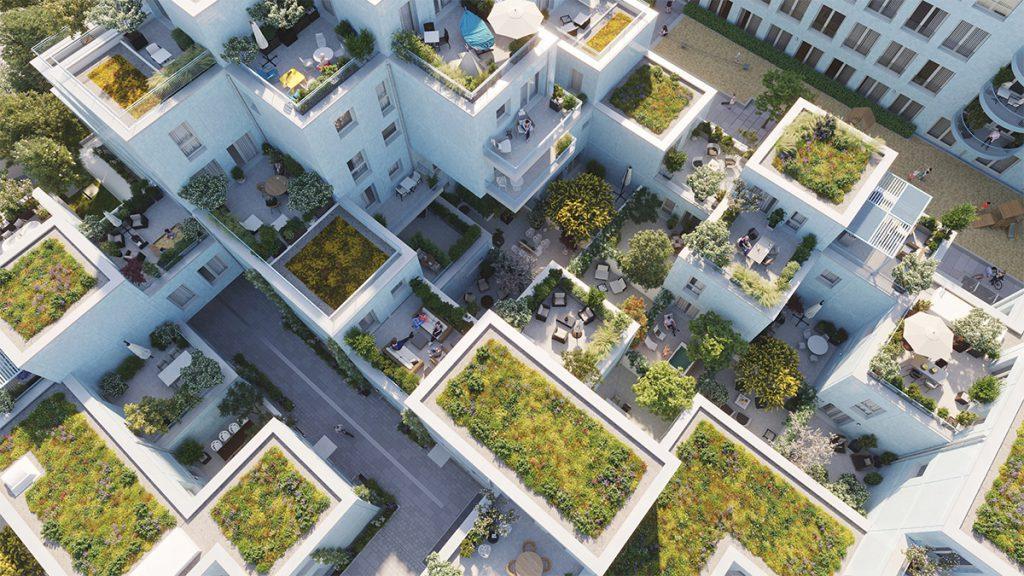
In the west of Cologne, a new residential neighbourhood called “Ehre und Liebig” is being built, with the feel of a holiday village. Divided into small areas, green and suitable for all lifestyles, the project offers flats, townhouses and shops for everyday needs.
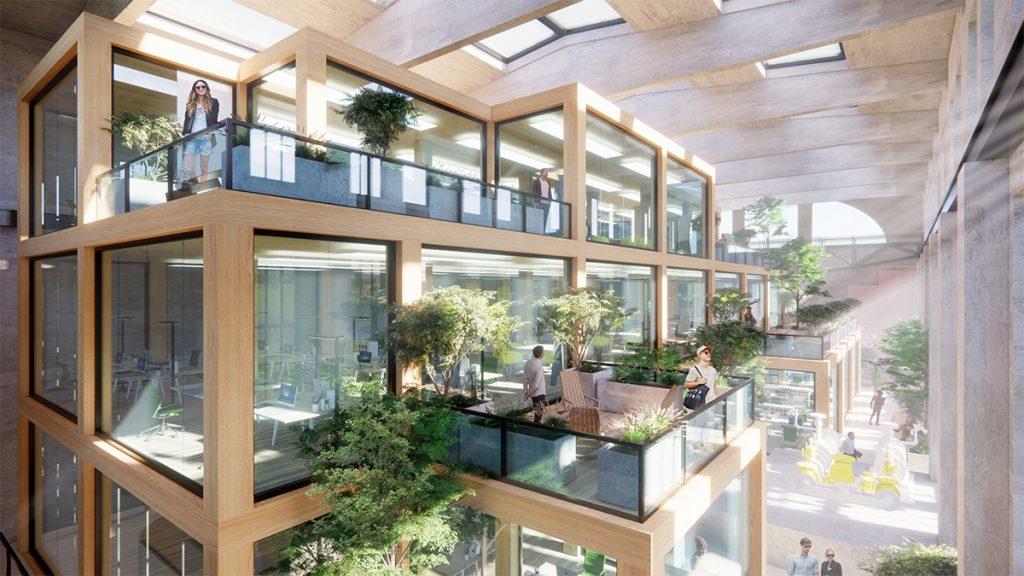
Reusing old buildings helps to protect the environment and scarce resources. As the architects from 3deluxe in Wiesbaden demonstrate, this can be achieved even in the trickiest of settings, creating state-of-the-art workspaces in the midst of industrial history.
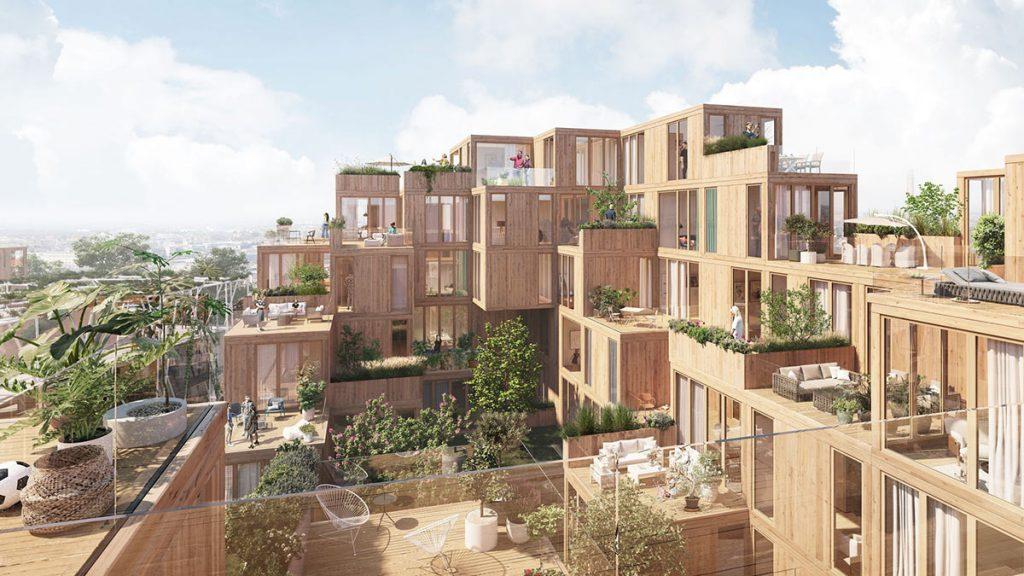
A competition entry submitted by architectural office Querkraft in Vienna shows the role that timber can play in increasing urban construction density. With extensive soil unsealing and greening, it also helps to create a cooling urban woodland in a Bielefeld district.
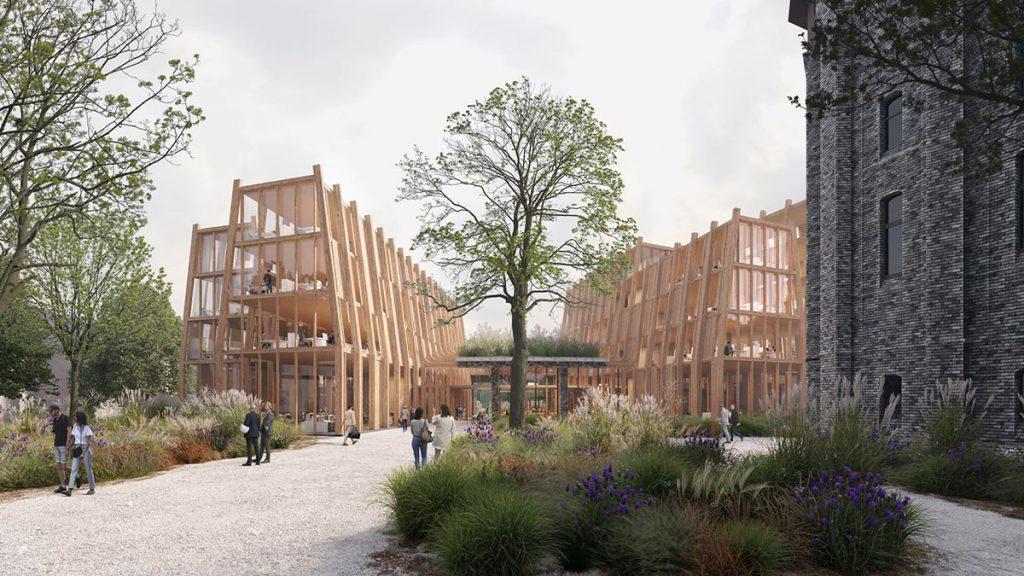
Industrial wastelands need new strategies to present workable options for re-use. The architects at Smartvoll are experts in this kind of development. One of their designs is an ecosystem for the former railway depot in Amstetten, Lower Austria, as living space for plants, animals and people.
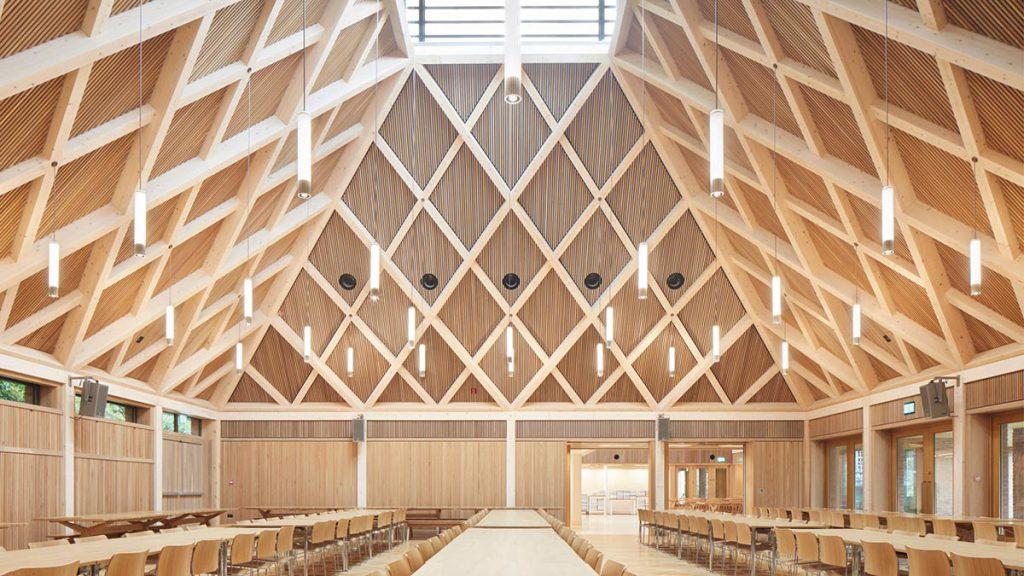
Its roof looks like three pyramids atop a space of celebratory grandeur, a wooden construction reminiscent of timber-framed buildings. This is precisely what the architects at Maccreanor Lavington had in mind for the new dining hall at Ibstock Place School.
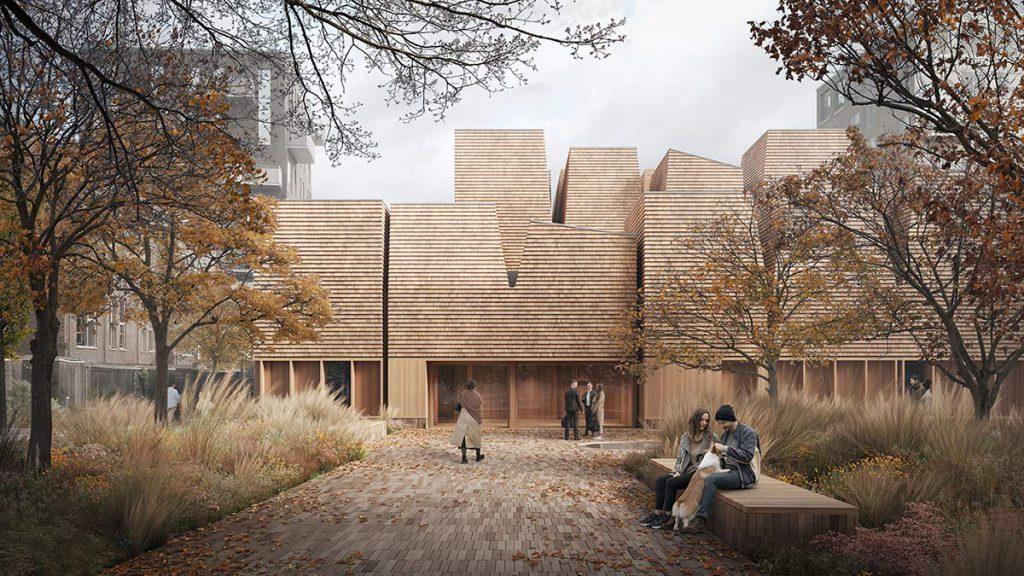
As the first church to be built in Copenhagen for 30 years, it may well become an icon. Ørestad Church is a sculptural timber construction designed by Henning Larsen. A kind of “Church 2.0”, it is also a modern community centre that reaches out to everybody regardless of their belief.
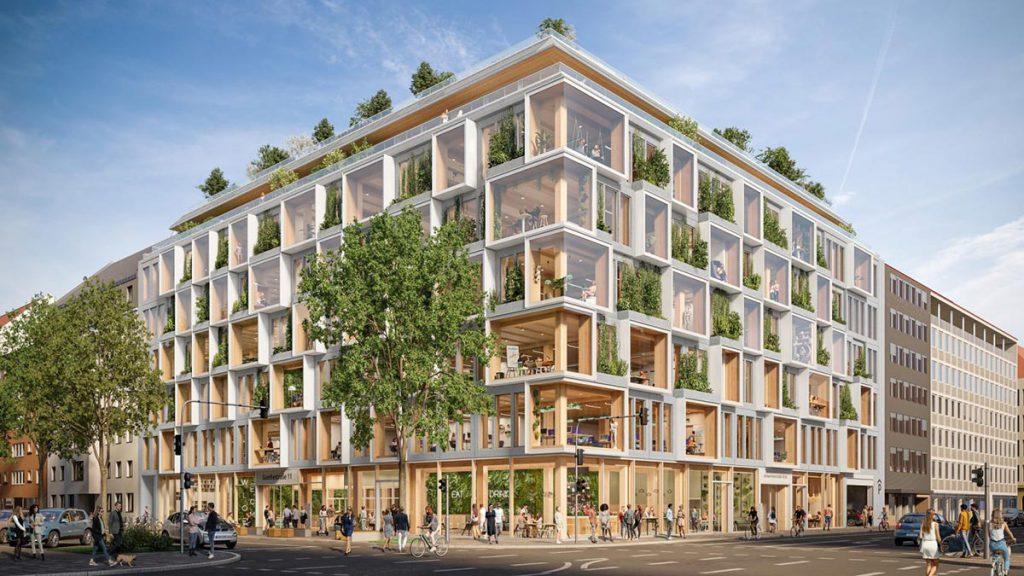
Following completion of Germany’s largest timber housing development in Munich, the city’s first timber hybrid office complexes are now being built. Developed by Accumulata, these projects will offer sustainable workplaces for the future and also construction materials that remain in the loop.
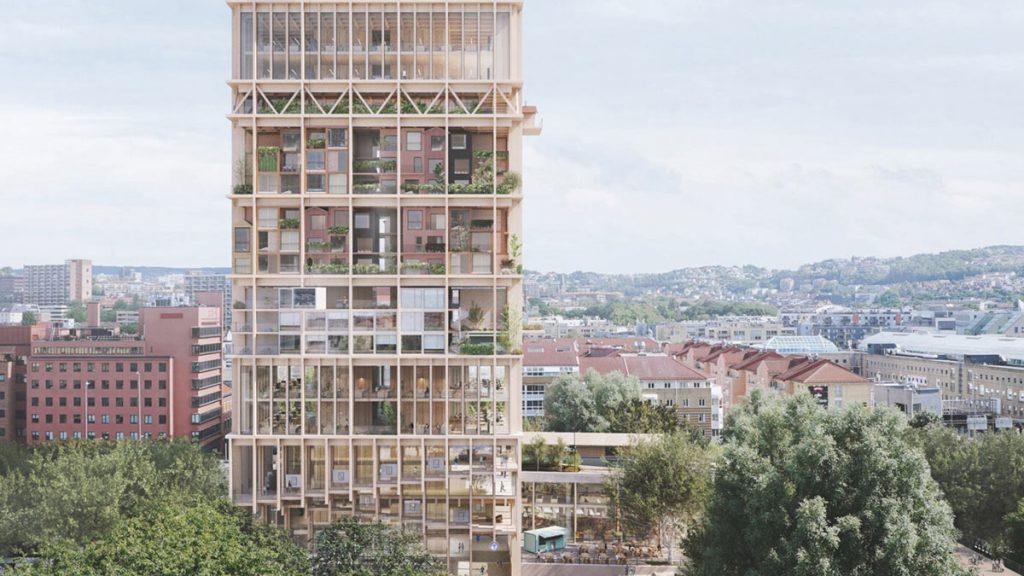
The high-rise for the future is built of wood and can be reconfigured at any time. A prototype called the Regenerative High-Rise has been designed by Haptic Architects and Ramboll to be freely adaptable. It is also a sign of a long life ahead for the concept of compact living in tomorrow’s world.
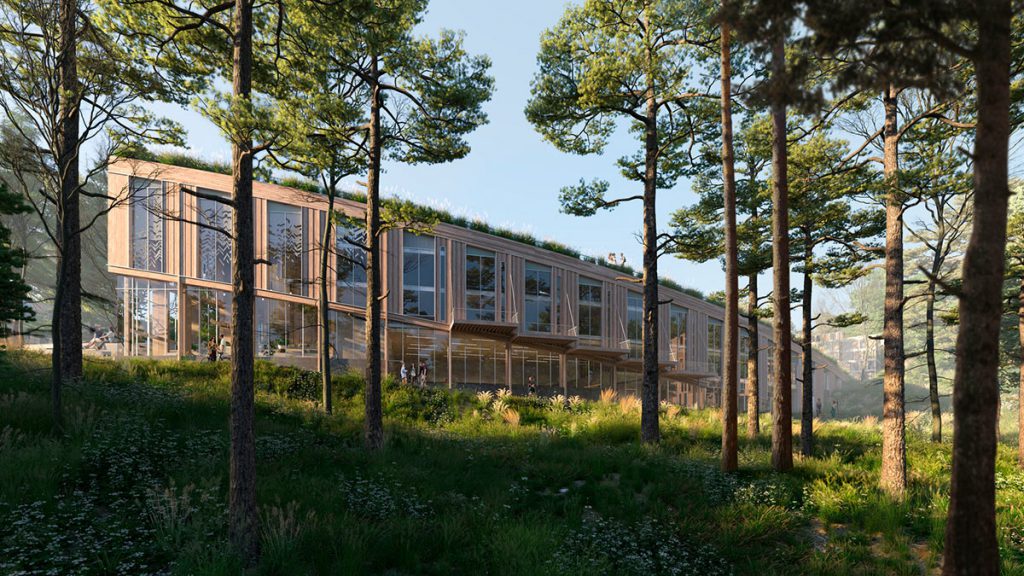
Wendelstrand near Gothenburg is a new community and housing development with social and ecological sustainability, sited in a disused quarry. The master plan and Lakehouse by the architects at Snøhetta show how urban planning and housing construction can be reimagined.
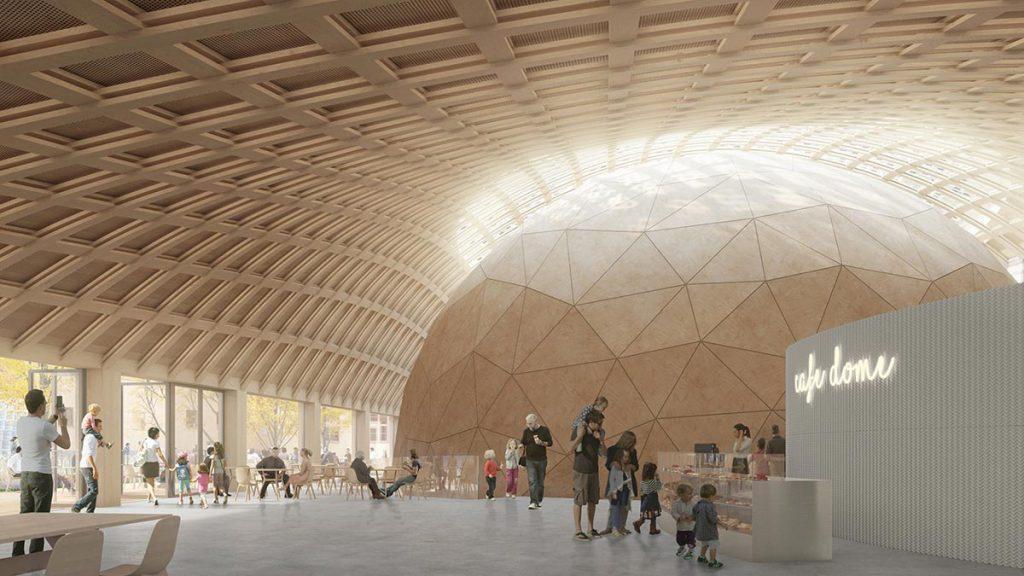
One of the world’s most spectacular timber engineering projects was recently completed in Sweden. Built for Stockholm’s Tekniska Museet, the Wisdome is a free-form structure using 20 kilometres of laminated veneer lumber. The design uses this kind of wood in an entirely new way.
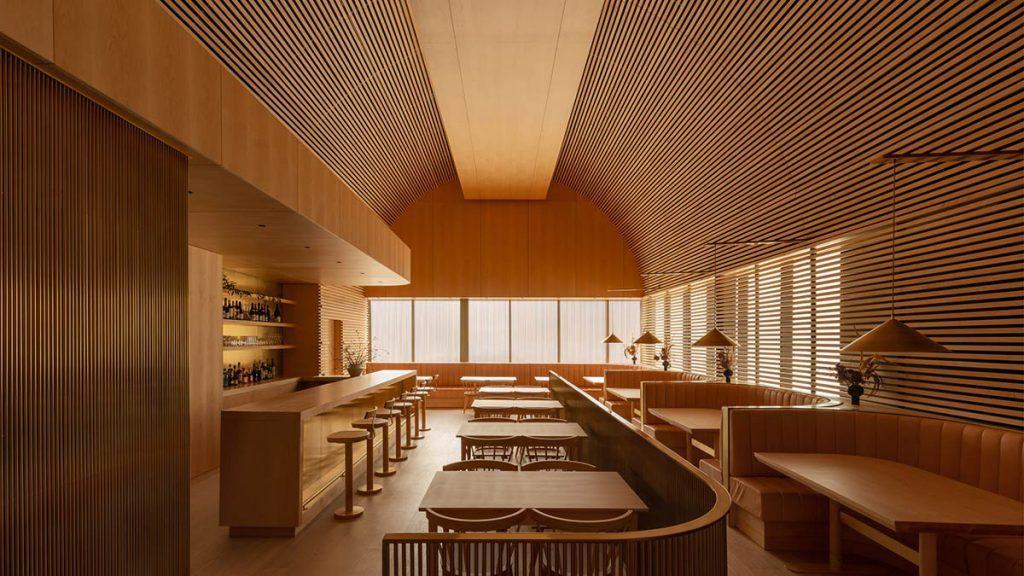
Canadian celebrity chef and internet star Matty Matheson teamed up with architect Omar Gandhi to create a restaurant landscape consisting entirely of wood, from top to bottom. There is little sign of rustic, folkloristic romance here, though.
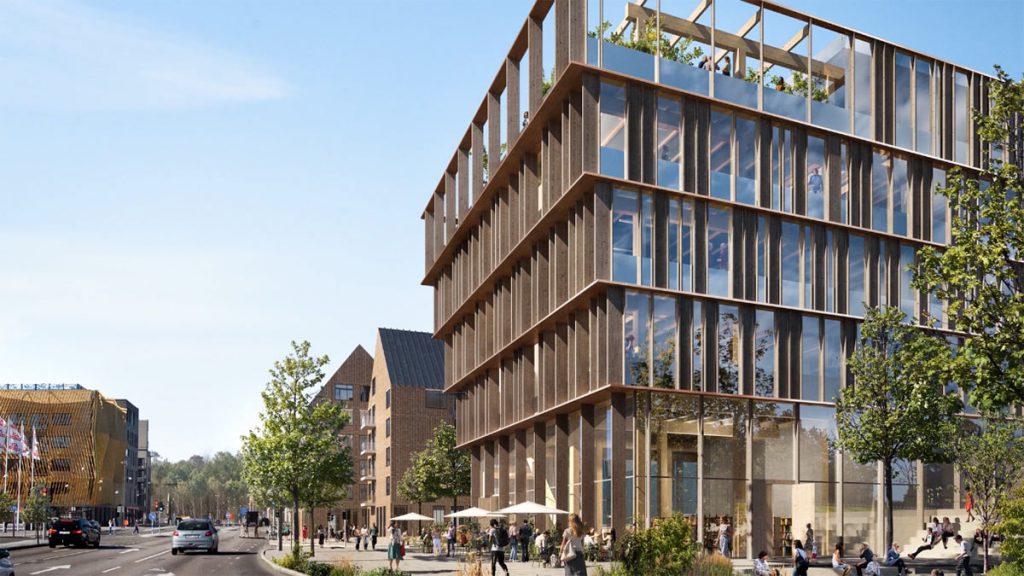
Completed in Gothenburg and made of wood, Nodi was named business building of the year 2021. It is another prestigious timber construction in the portfolio of White Arkitekter, the architects responsible for timber high-rise Sara Kulturhus in Skellefteå.
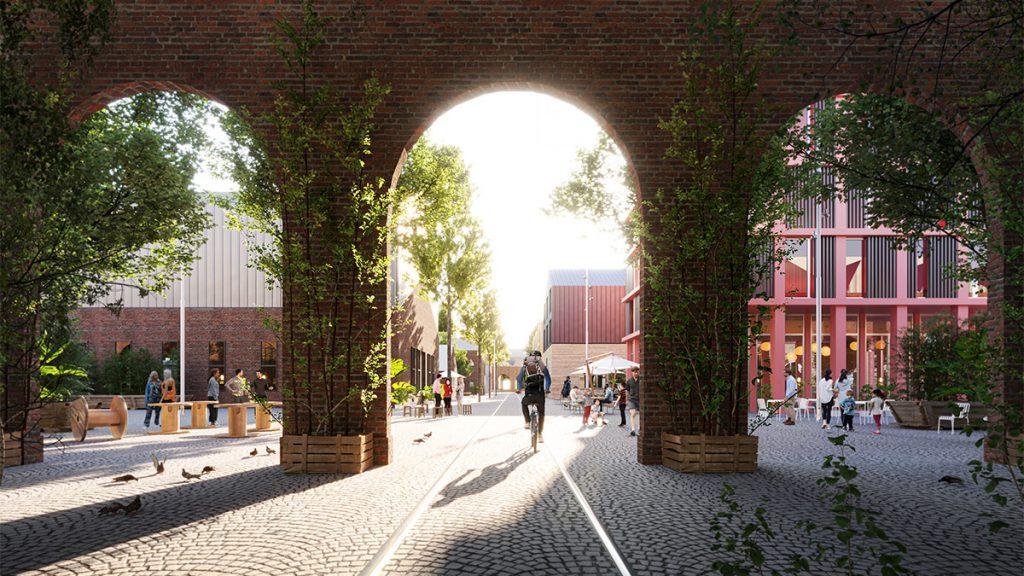
Jernbanebyen is being developed right in the centre of Copenhagen, based on plans drawn up by Danish architectural office Cobe. Formerly a railroad yard, the area is being transformed into an innovative green district. It will be partially car-free, with repurposed listed buildings and lots of new ideas for improving the quality of life.
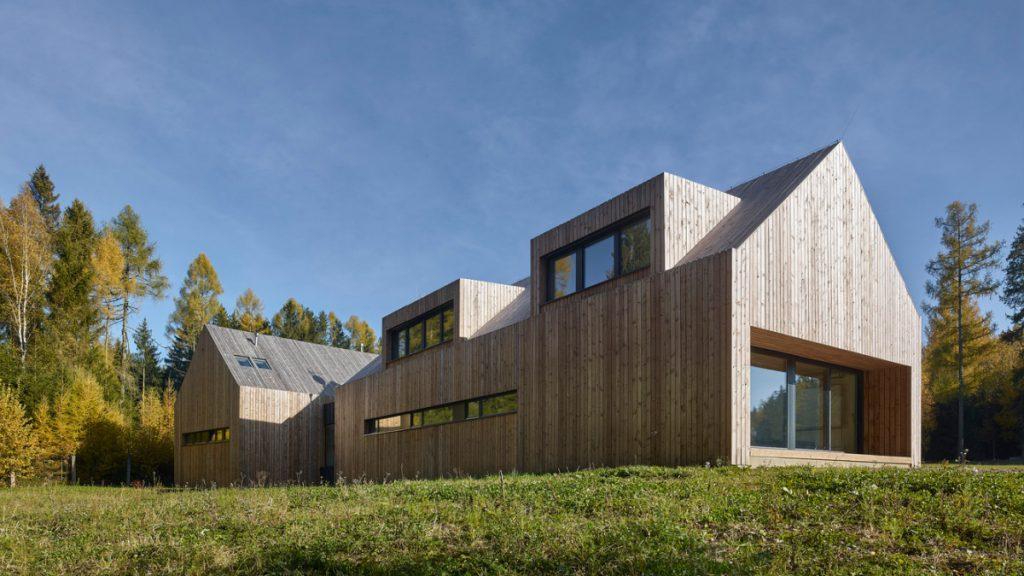
Dense, green forests are often synonymous with calm, nature and unspoiled landscapes – but they also need care and attention. Such forestry operations can inspire interesting architecture, as shown by the Forest Administration Lodge in Czechia.
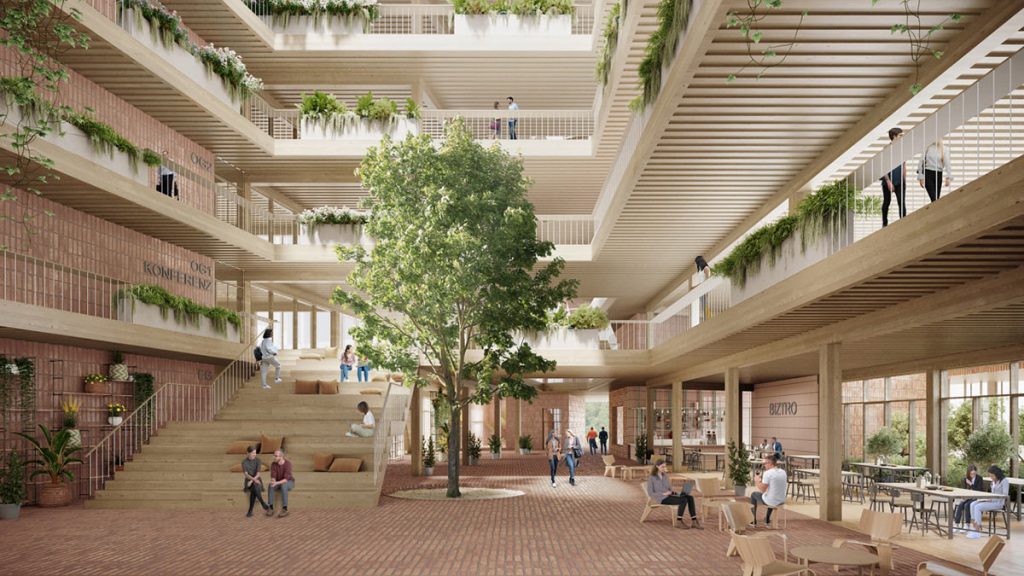
The teams at Berlin Waste Management are out and about day in day out, keeping Germany’s capital city looking good and ensuring resources remain in the cycle. Their new headquarters in Südkreuz have the same aspirations and are a prime example of sustainable ideas.
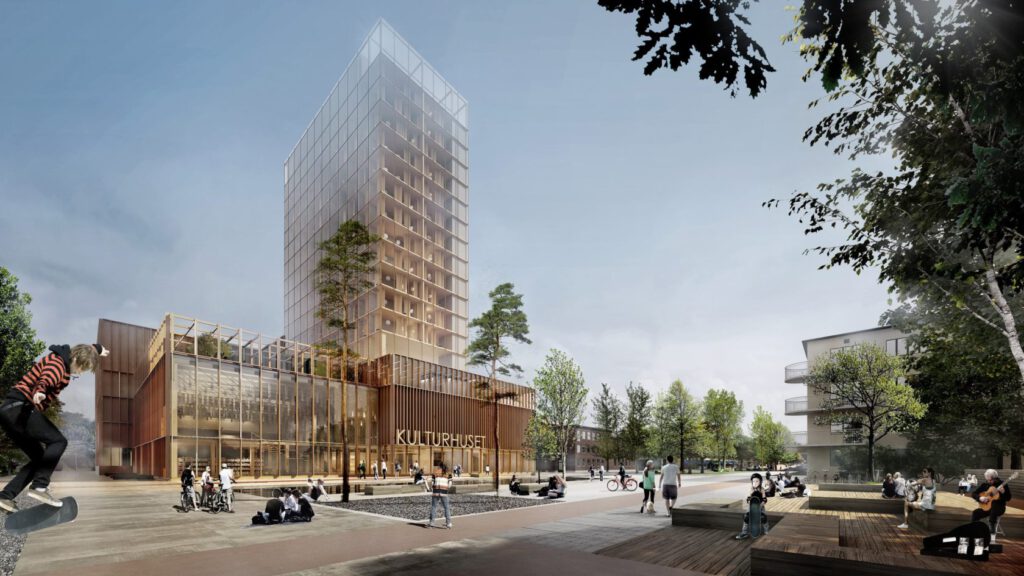
Their pioneering timber high-rise gained international recognition for the architects at White Arkitekter. Researcher and architect Jonas Runberger explains why computational design processes are so important for reaching climate goals.
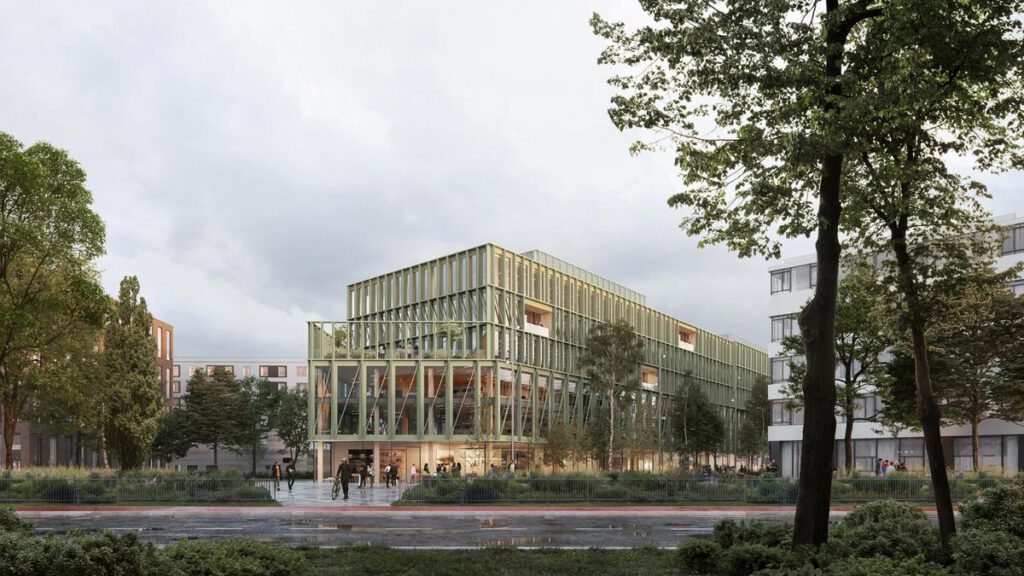
Its facade is made from recycled aluminium, and the load-bearing structure follows a hybrid timber design. Named i8, this office building in Munich’s Werksviertel is committed to decarbonization and forms a link with the neighbourhood’s industrial past.
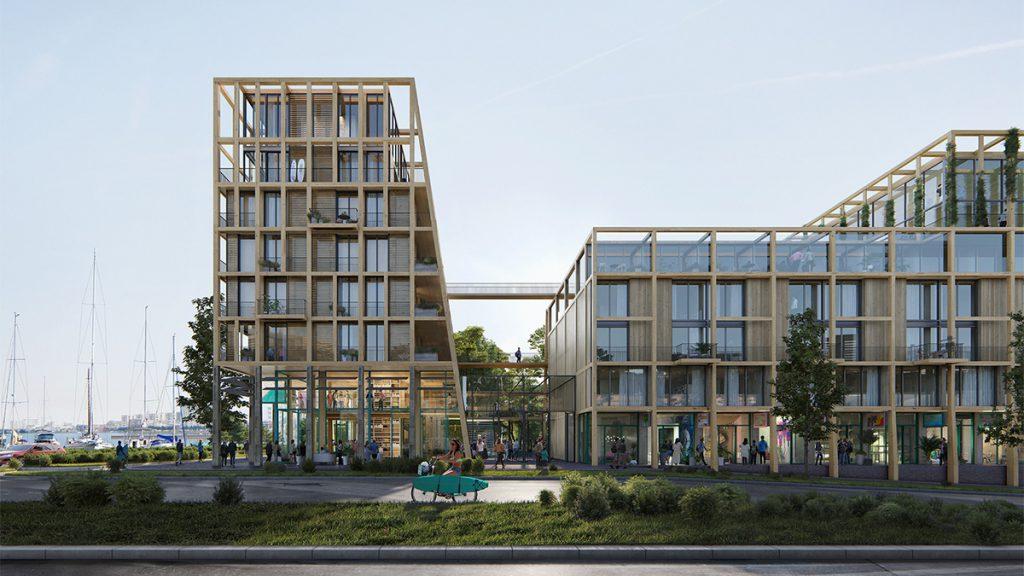
Marc Koehler and ANA Architects have joined forces to build the Netherlands’ most sustainable and affordable timber mid-range residential complex, with its own tiny forest. The name of this visionary project in the Amsterdam district of IJburg? Robin Wood.
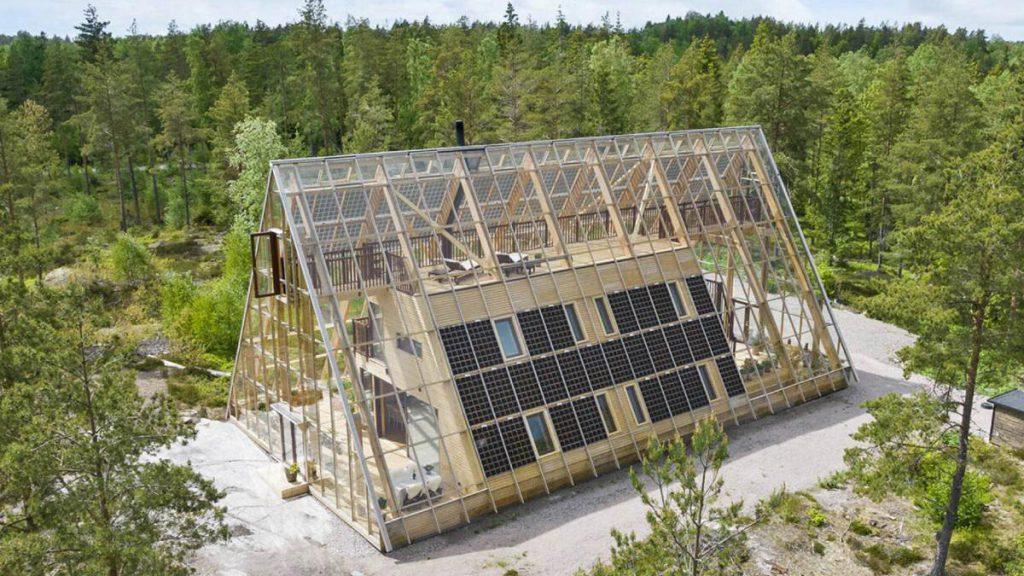
Rising energy prices won’t affect people who live in Atri, a building designed by Swedish provider Naturvillan. They will be wholly self-sufficient with solar energy, home-grown vegetables and a water treatment plant.
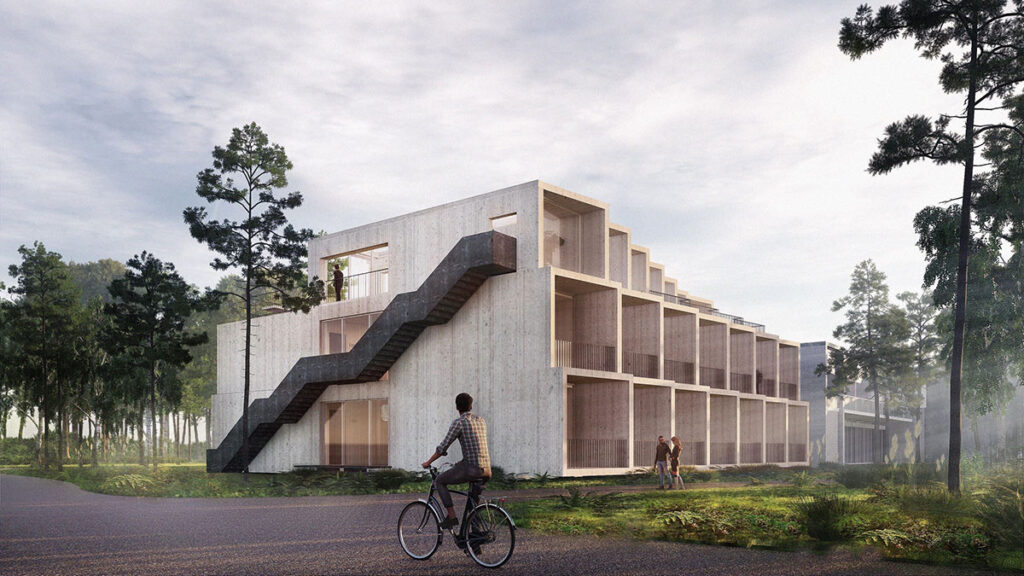
Situated on the Danish island of Bornholm, the Green Solution House hotel features smart rooms and real-time energy and resource monitoring. The hotel designed by 3XN/GXN has raised the bar with its climate-positive timber wing.
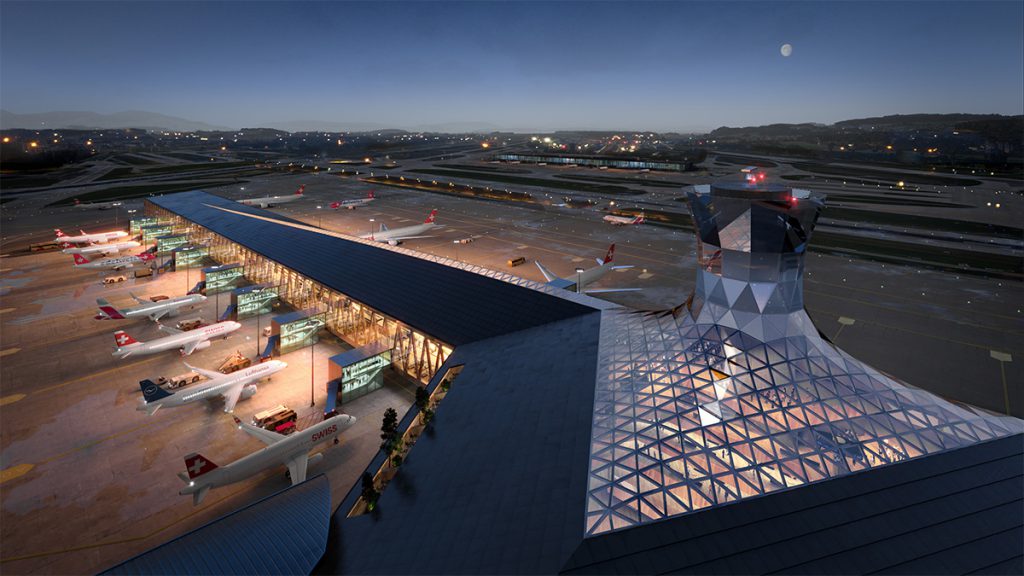
Sustainability is reaching new heights for the new design of Dock A at Zurich Airport. In the design competition organized by Flughafen Zurich AG, the jury selected “Raumfachwerk”, a project submitted by BIG, HOK and 10:8 Architekten consisting primarily of timber.
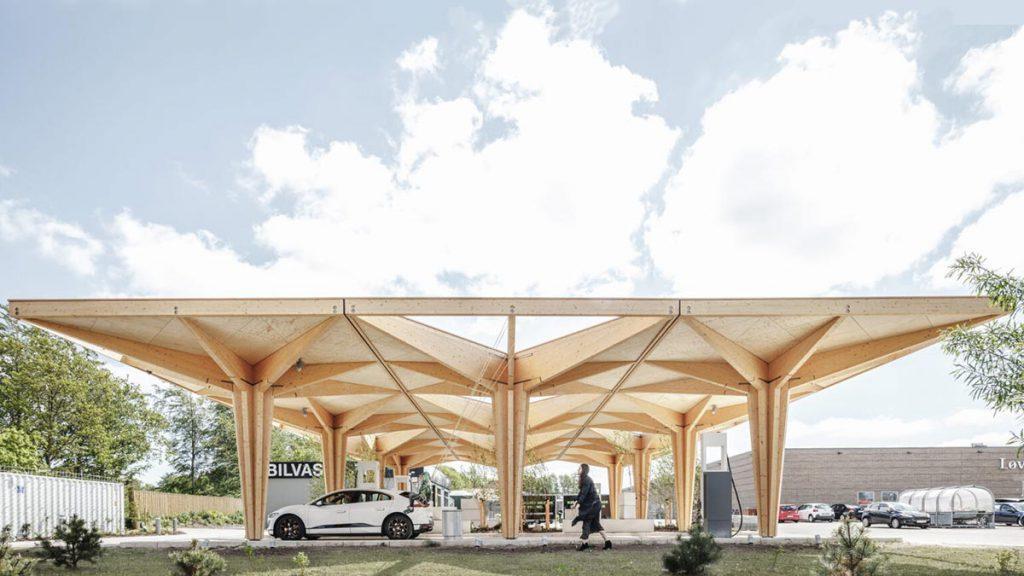
The filling station of the future will be not just fossil-free, green and clean, but also a place where motorway travellers can relax and recuperate. With this in mind, a modular, ultra-fast charging station built with timber has been designed by Danish architectural studio Cobe.
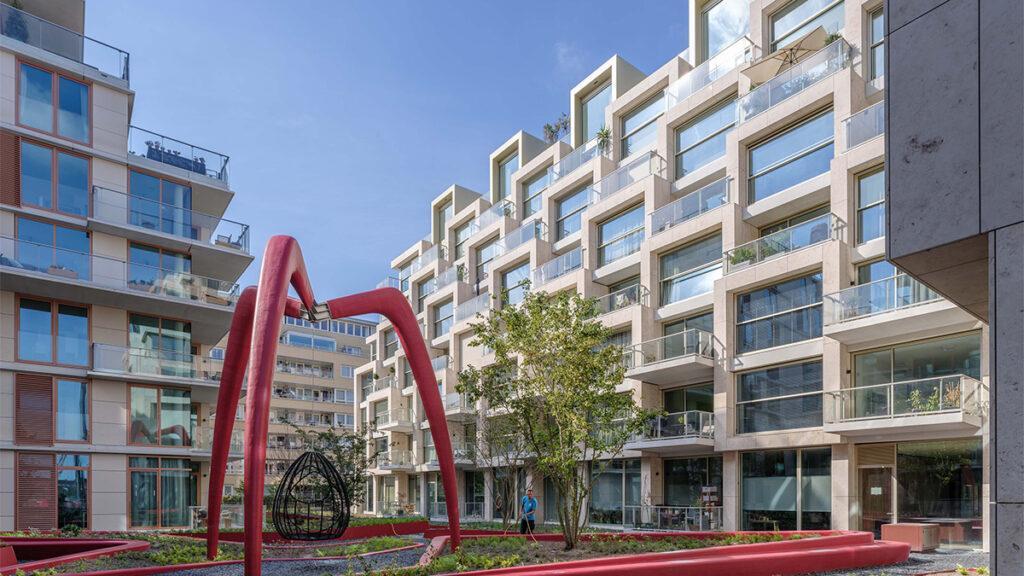
The Grid is a special kind of building that has been designed for Amsterdam by Dutch firm KCAP. Recently completed, this apartment block looks as if it were made entirely of balconies. And that’s by no means all that makes it such a liveable home.
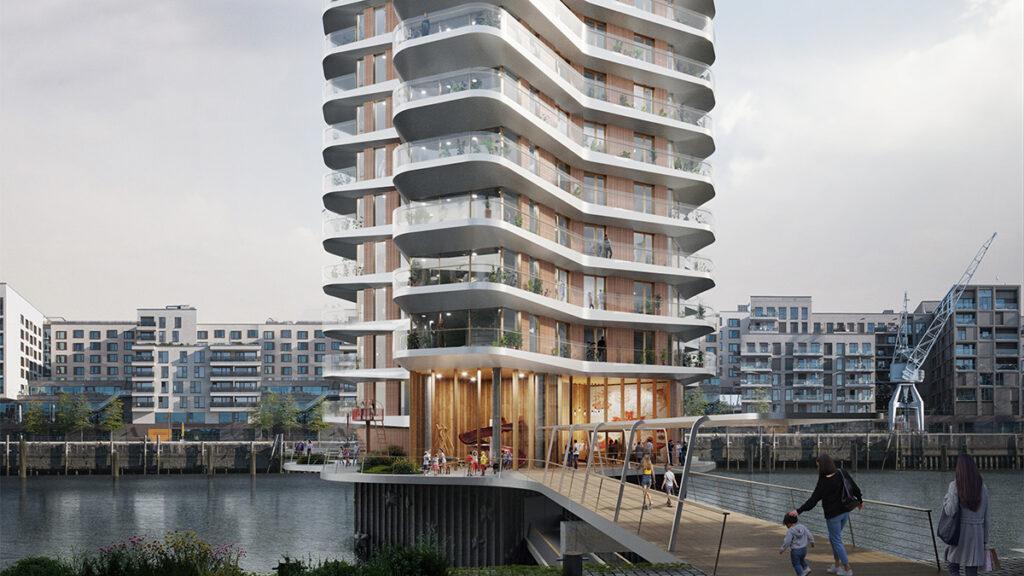
Sustainable, individual yet blending in perfectly with the ensemble: this is the description given to the “water house” to be built by KCAP on Hamburg’s waterfront. It will be a future-oriented residential tower that will provide the HafenCity with another example of stimulating architecture.
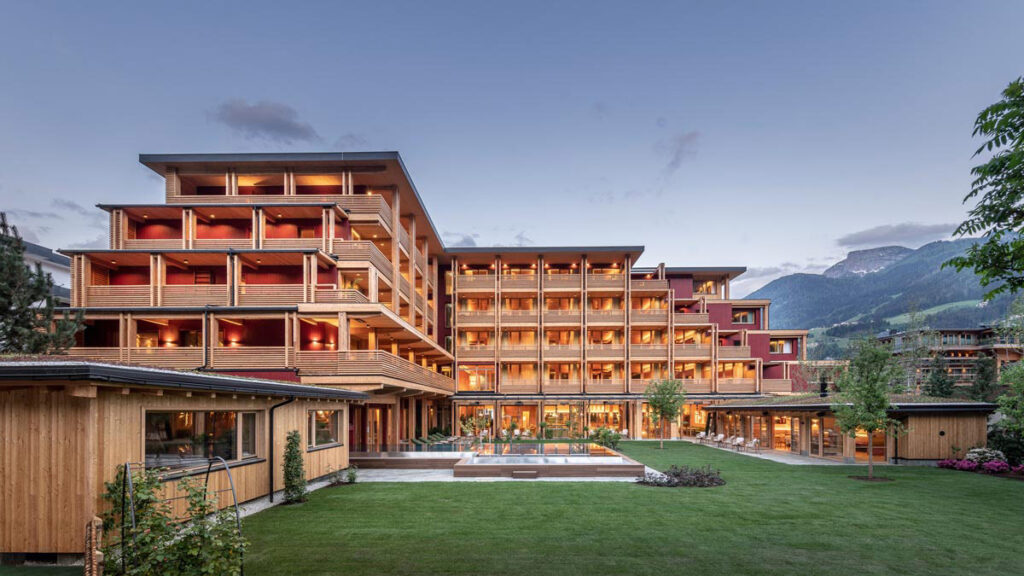
The first five-storey hotel in mass timber design is located in Zillertal, Austria, created by celebrated Italian architect Matteo Thun. It is no coincidence that one of the leading players in structural timber construction is based only a stone’s throw away.
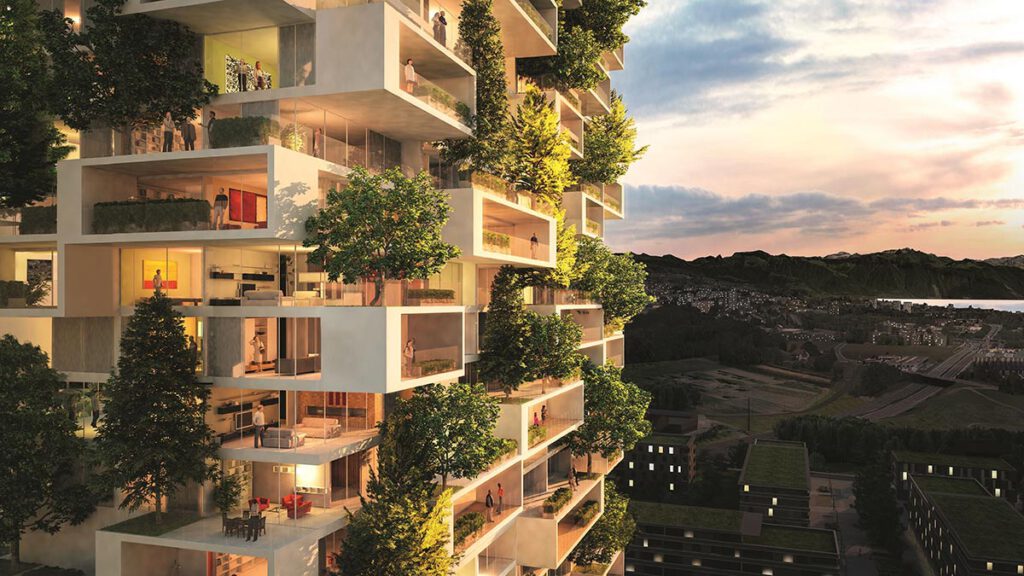
Stefano Boeri is regarded as a pioneer of biodiverse architecture. The Torre dei Cedri planned for the outskirts of Lausanne will be another of his spectacular towers. This time, the vertical forest will consist of over 80 trees.
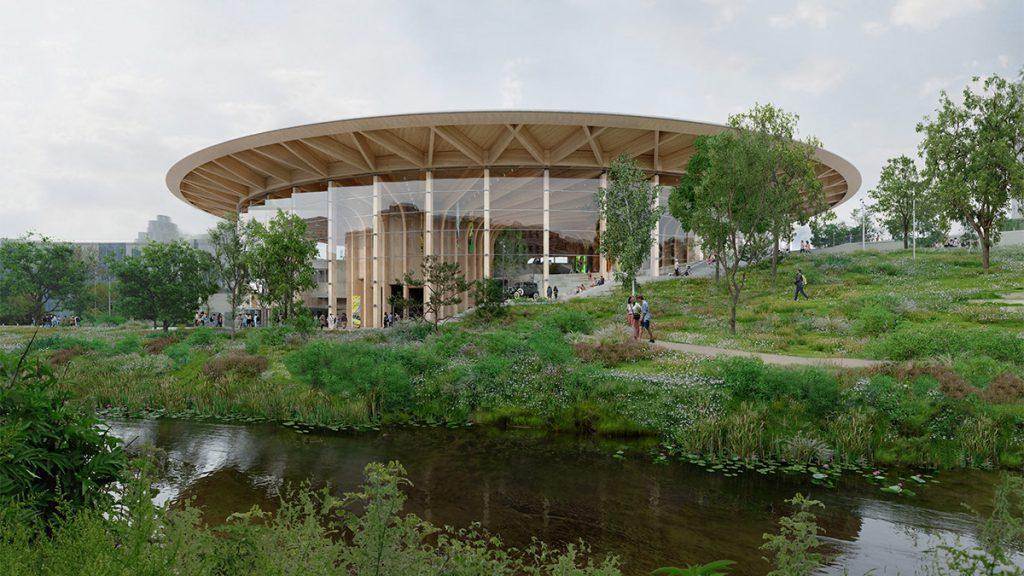
A special kind of discovery world is taking shape in Gothenburg, where Swedish vehicle manufacturer Volvo is using timber construction and nature to create its World of Volvo. The components and engineering for Henning Larsen’s design are being provided by Austrian firm Wiehag.
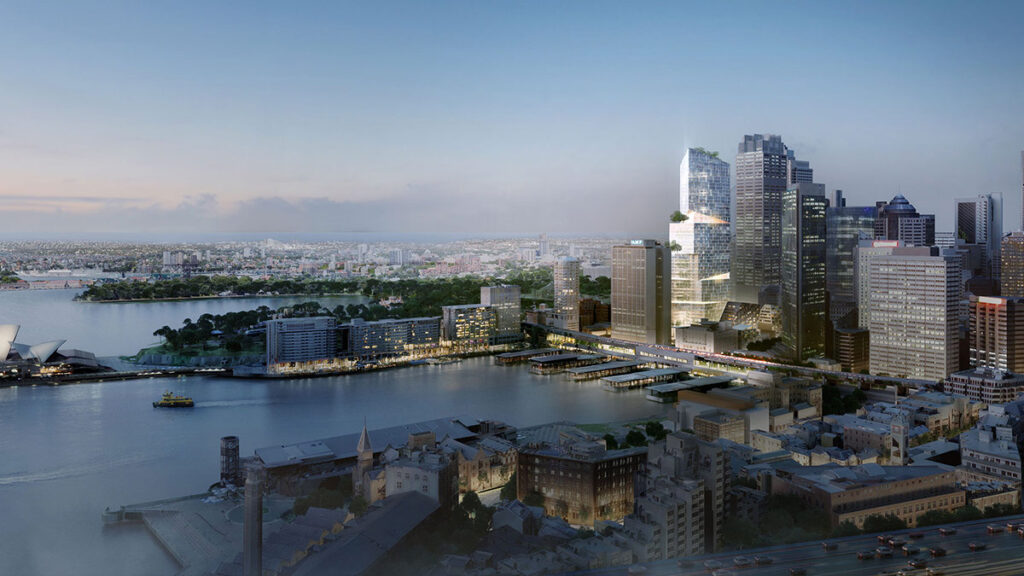
Danish architects 3XN are operating a separate division called GXN that develops green innovations. In this interview, Kim Herforth Nielsen and Kåre Poulsgaard talk about behavioural design, carbon as a market driver, and their radical high-rise project in Sydney.
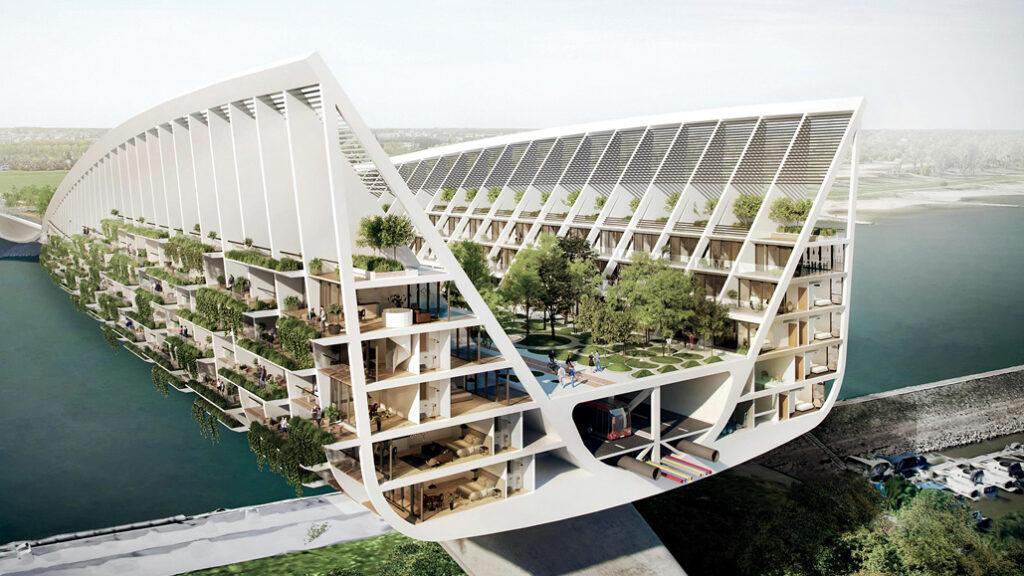
As Dusseldorf’s Theodor Heuss Bridge needs a complete overhaul, the team at RKW Architektur + put their heads together – and produced a spectacular new design. It is literally packed with potential.
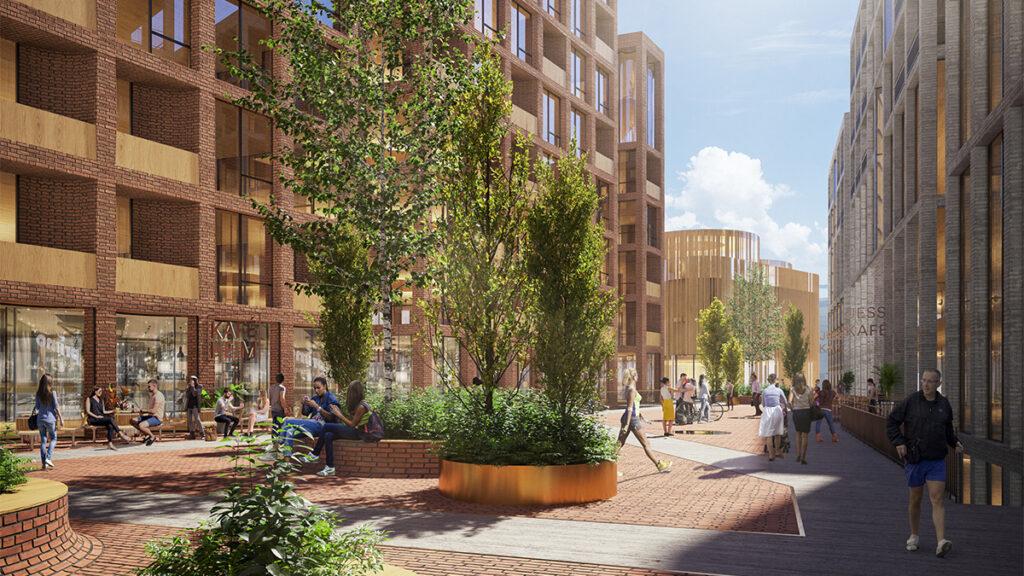
The town of Jessheim is getting an impressive new centre. Designed by Norwegian firm Mad arkitekter, it promises to combine sustainable urban development with attractive indoor and outdoor areas.
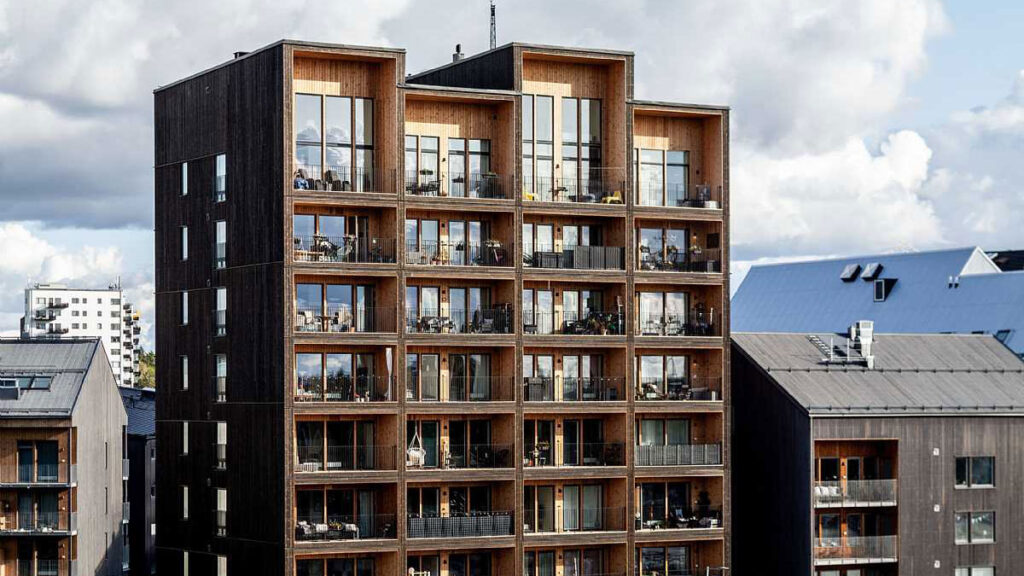
The Kajstaden Tall Timber Building in Sweden marks the beginning of a new generation of mass timber blocks. Using this building material saves around 500 tonnes of CO₂, and it also facilitates deconstruction later on.
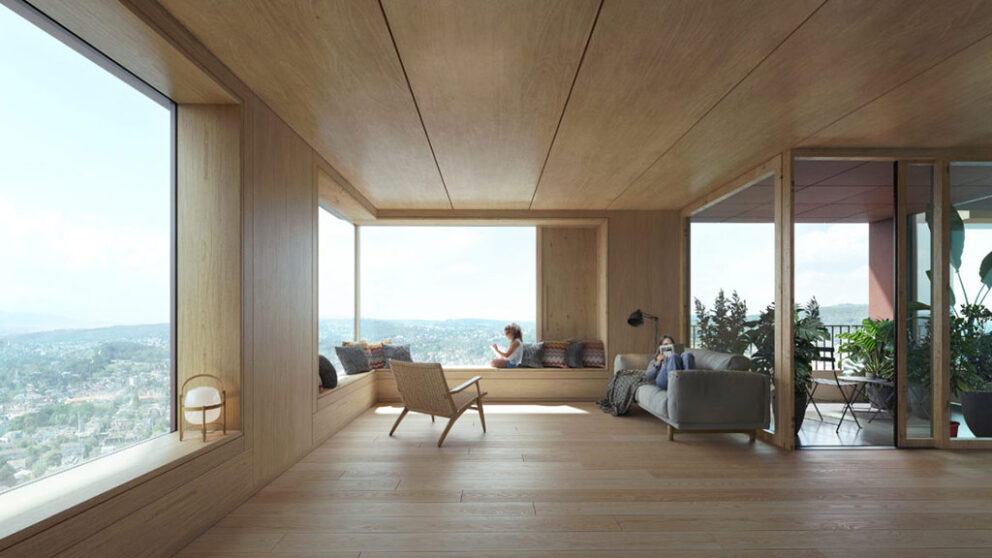
There’s a rocket preparing to launch in Switzerland. The residential timber high-rise named Rocket in Winterthur’s Lokstadt neighbourhood will reach a height of 100 metres. The tower’s residents will be part of the 2000-watt society.
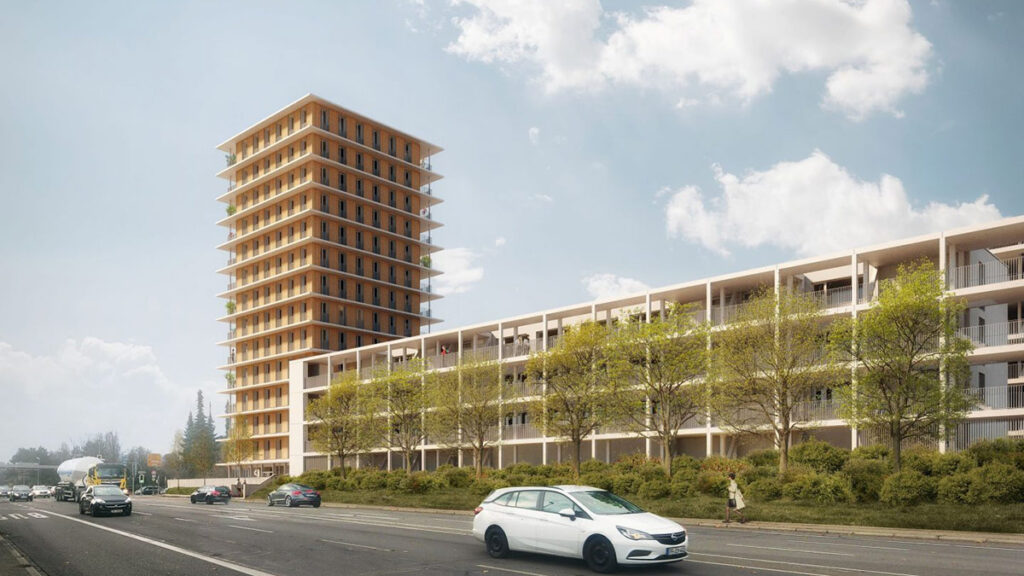
May we introduce Carl? Using timber for its facade besides the supporting structure, the apartment block is currently under construction in Pforzheim. Architect Peter W. Schmidt explains how this is being done.
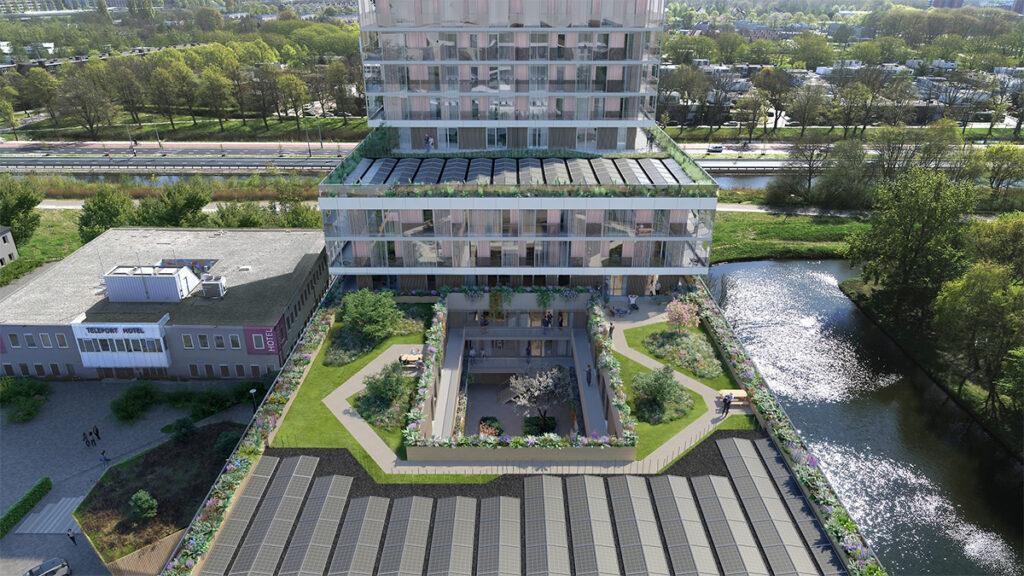
Who wouldn’t want to play a part in designing their own neighbourhood? The future residents of the pioneering Floating Gardens project get to do this. The new, sustainable complex in Amsterdam not only has a school, but also sets out to teach others what sustainable living is all about.
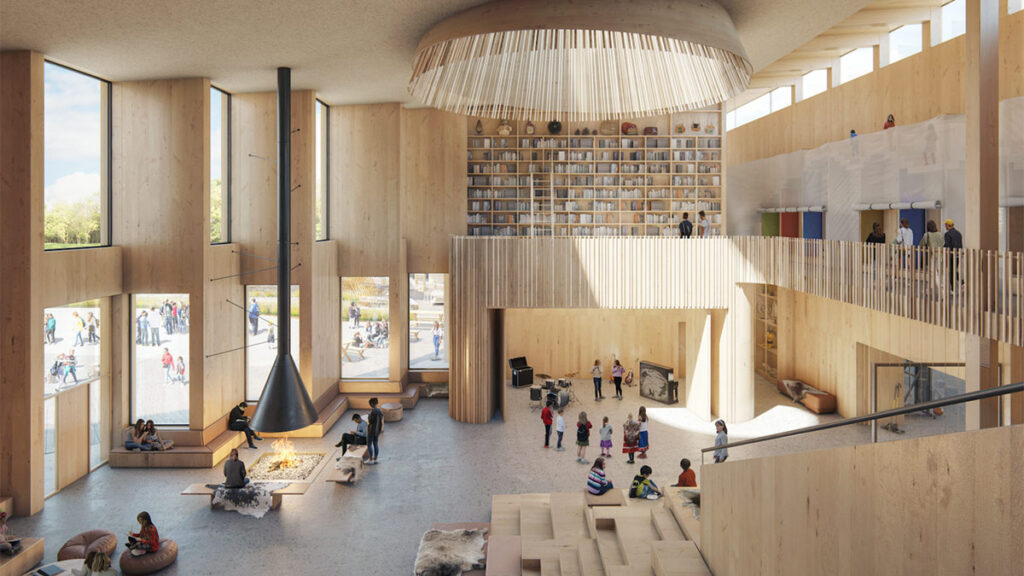
Kautokeino skole in northern Norway is a project that seeks to embrace the uniqueness of Sami culture and educational style. The mass wood building is so hygge, you’ll want to check in for a few nights.
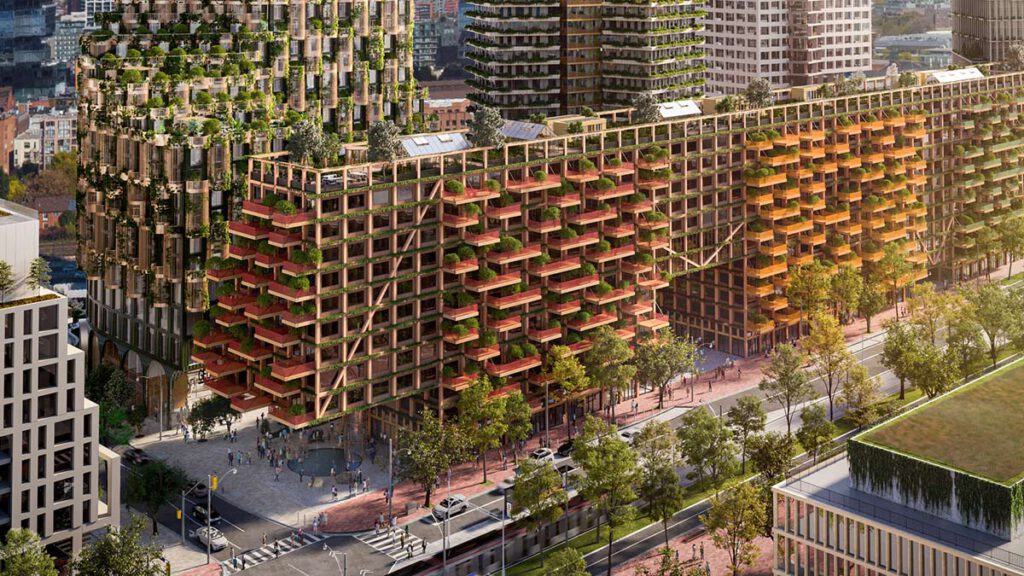
Canada’s megaproject Waterfront Toronto includes a new district called Quayside, an all-electric and climate-neutral community. Its highlights are a two-acre urban forest and the residential Timber House by architect David Adjaye.
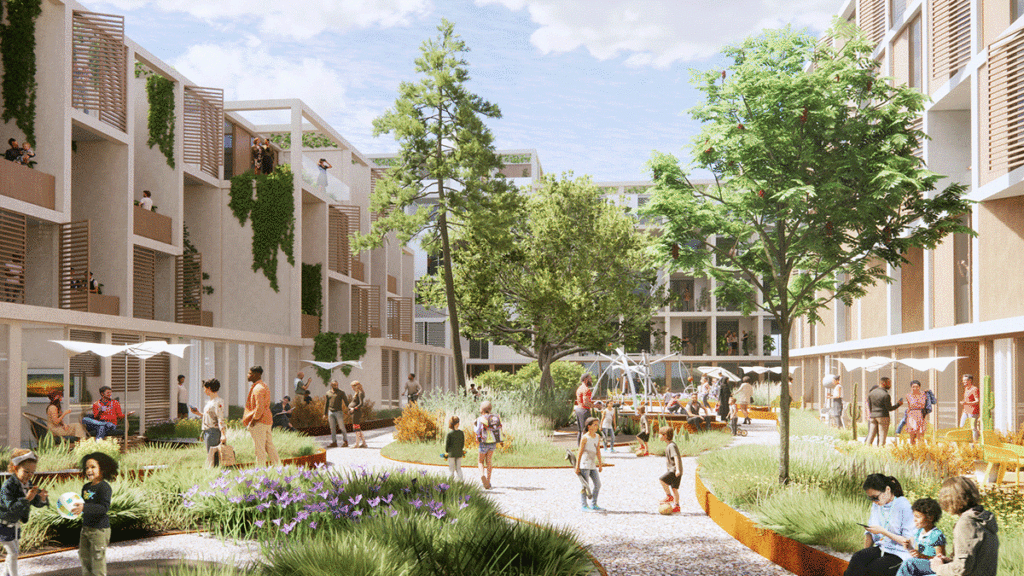
The city of San Diego in Southern California has plans for a new district, one that will be entirely void of cars. Known as Neighborhood Next, it must be one of the most radical projects in the USA.
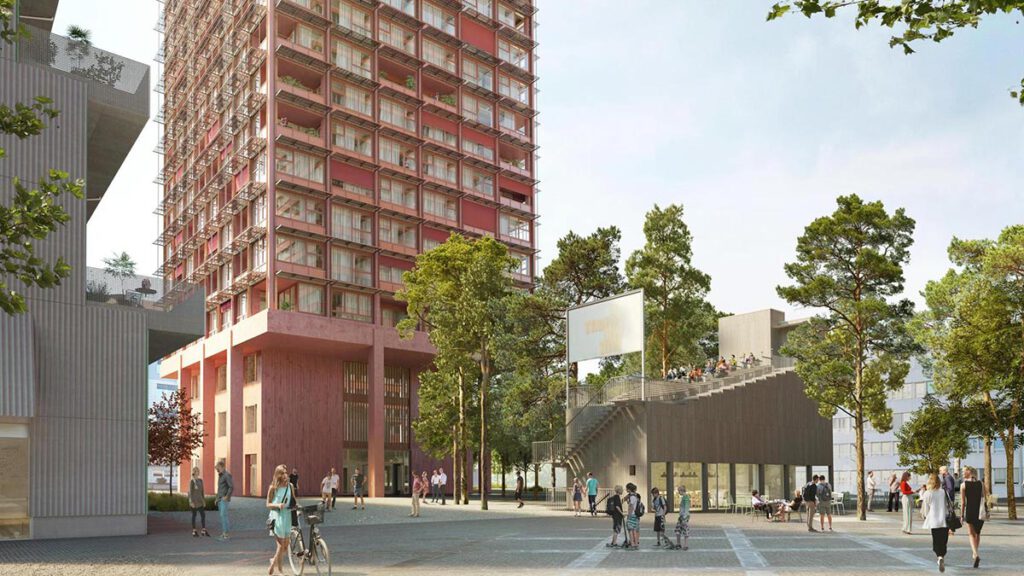
The new urban quarter Zwhatt near Zurich is designed to enable climate-neutral living at affordable prices. One of its buildings is a 75-metre-high timber hybrid tower known as Redwood, whose facade generates solar power.
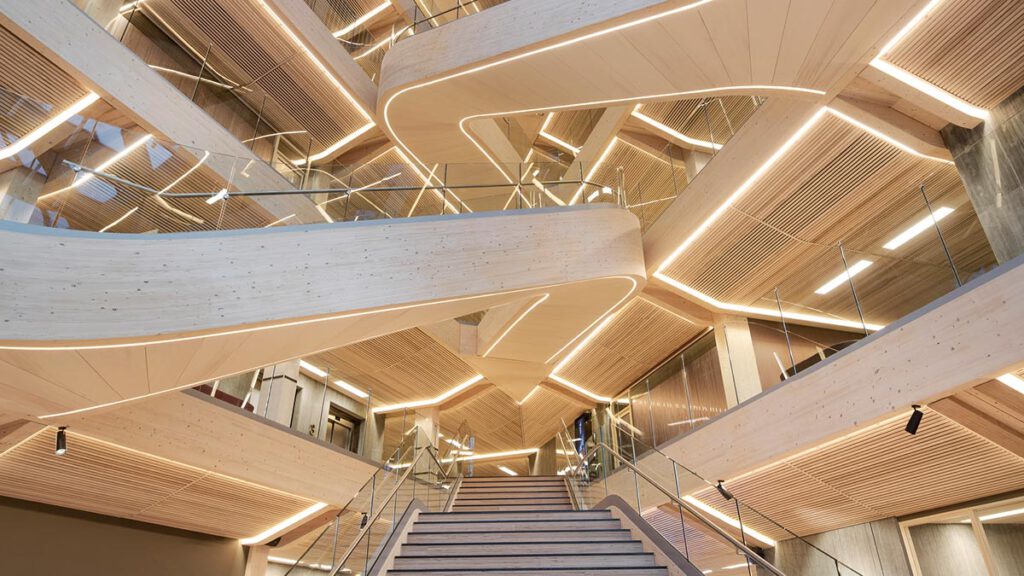
Timber construction can be decidedly high-tech, as illustrated by the head office built for SR Bank in Stavanger, Norway. Bjergsted Financial Park offers workplaces that are fit for the future, and it is among Europe’s largest engineered timber buildings.
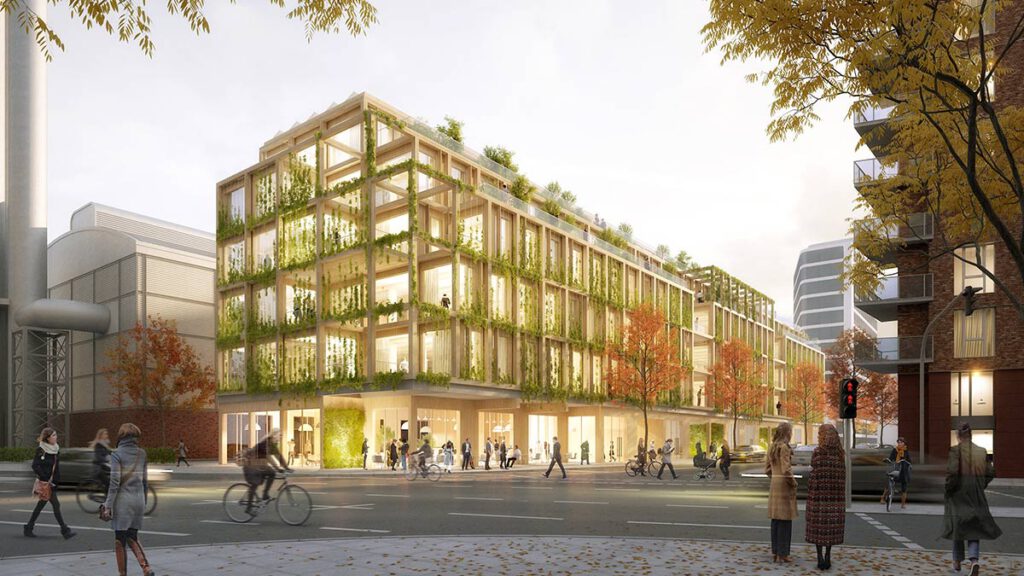
HafenCity Hamburg is an urban quarter fit for the future. Its eco cherry on the top is the “Null-Emissionshaus” (Zero Emissions Building), which is completely carbon-neutral – and can be dismantled like a Lego house.
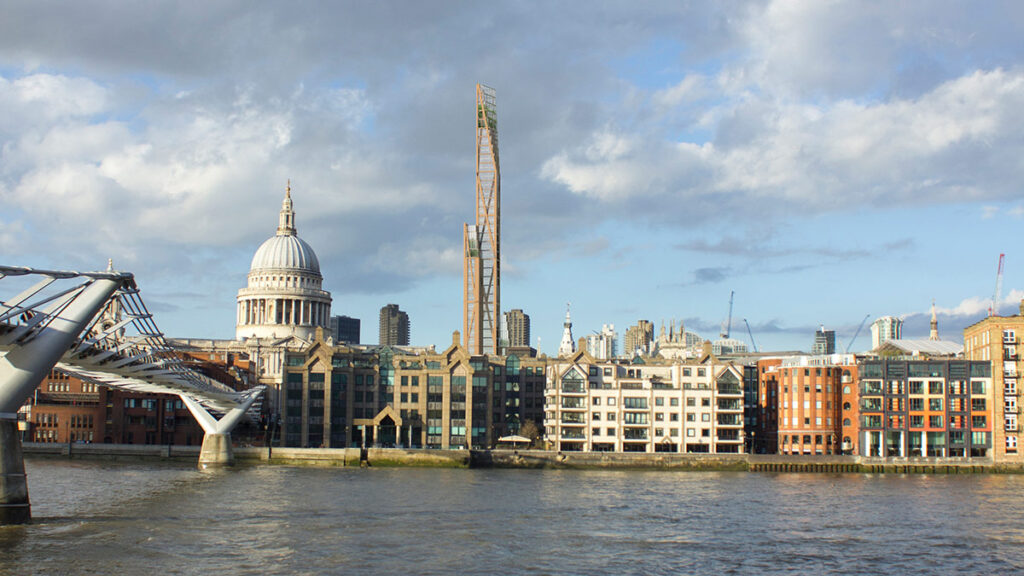
Researchers at Cambridge University are helping to turn London’s spectacular vision of a wooden skyscraper into reality. The Oakwood Timber Tower is to rise 300 metres into the sky, almost level with the tallest building in the city.
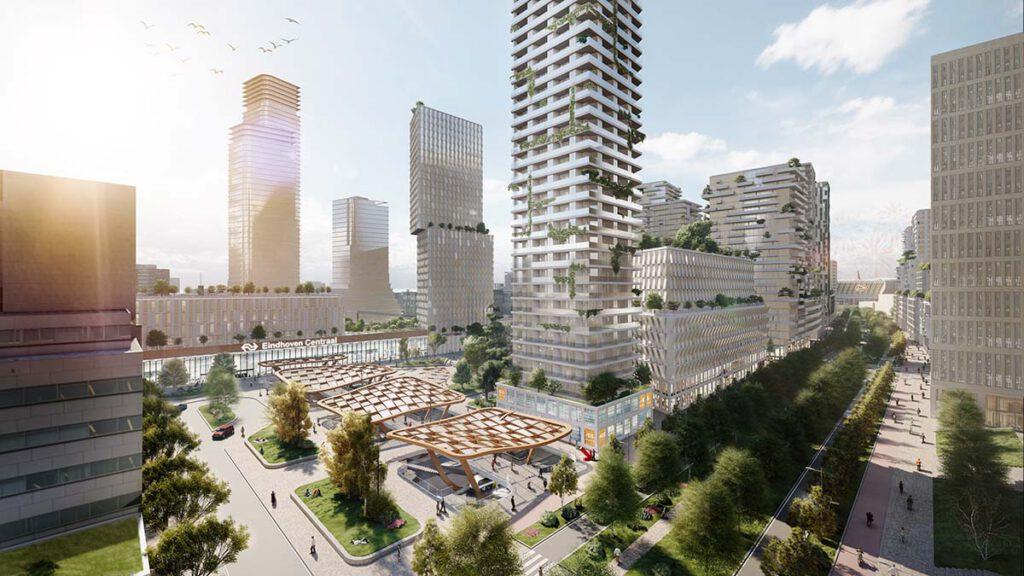
What used to be a single-purpose neighbourhood is being transformed into a versatile motor of urban progress: Eindhoven is turning its railway station district in Fellenoord into a buzzing new area where all kinds of innovations are set to flourish.
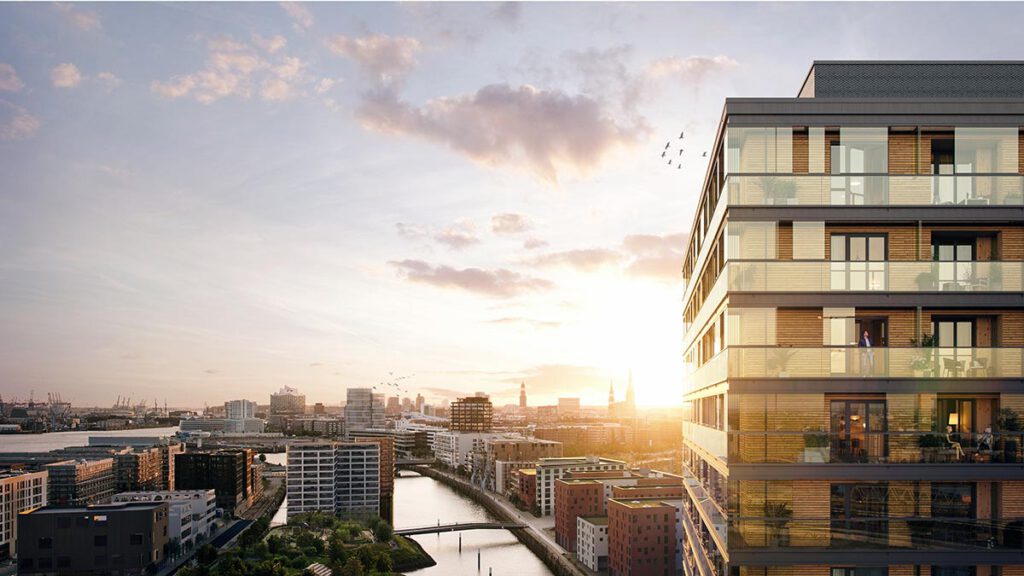
The eco-friendly residential project Roots will be the new landmark of Hamburg’s HafenCity and the tallest timber high-rise in Germany. Architect Jan Störmer reveals what its future residents will have in common.
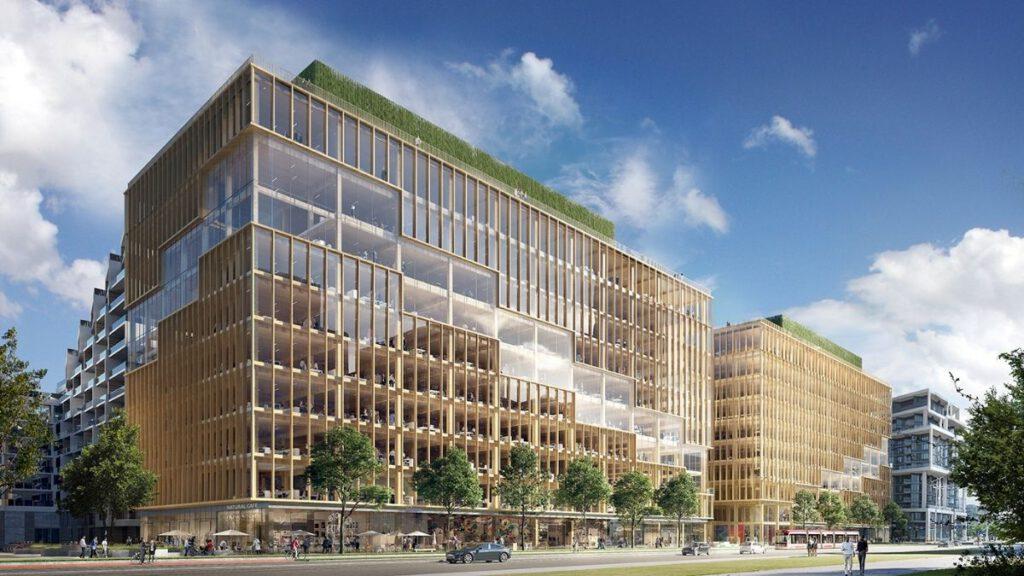
The Danish office 3XN is planning to build North America’s tallest timber office building in Toronto. Called T3 Bayside, the complex will offer more than 500,000 sq. ft. of next-generation office space when completed.
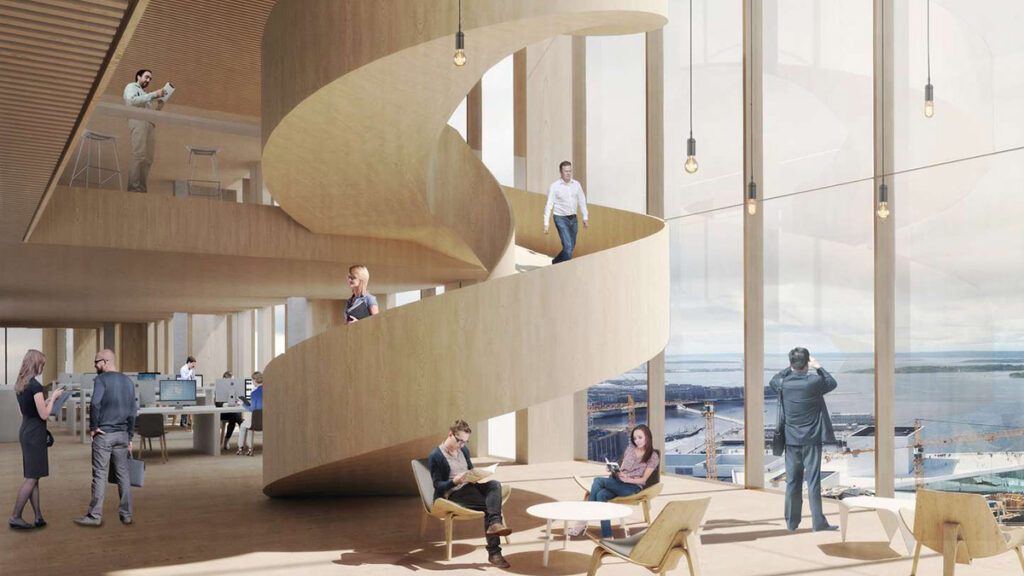
Oslo was once built entirely of wood. The project chosen to redesign the area around its railway station heralds the return of this traditional building material to the Scandinavian metropolis. A spectacular office tower with an innovative hub is being developed, named Fjordporten.
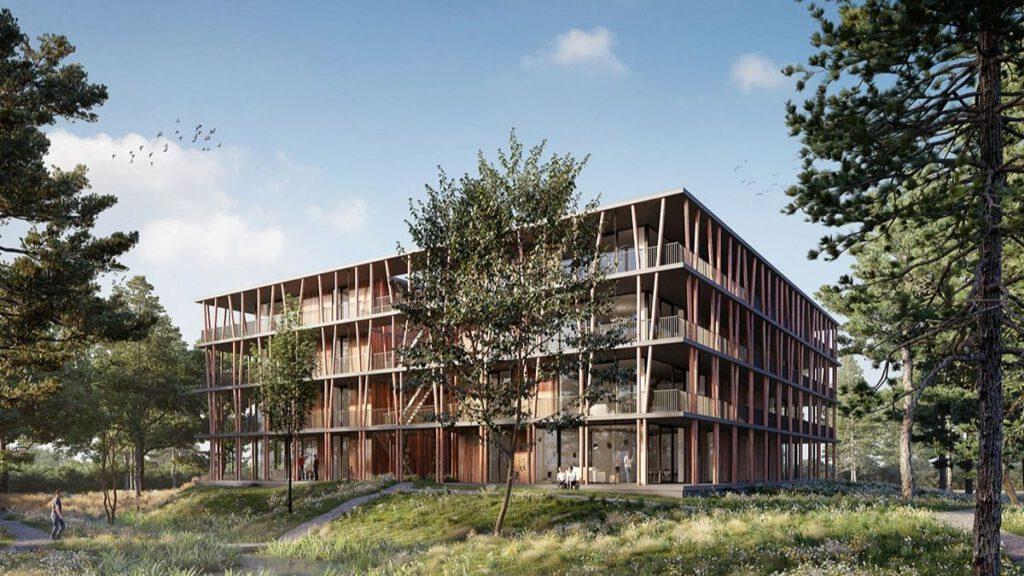
Dutch architectural firm Gaaga has designed a residential building in Eindhoven that is distinctly people- and environment-friendly. Surrounded by trees, it is situated in the middle of a park.
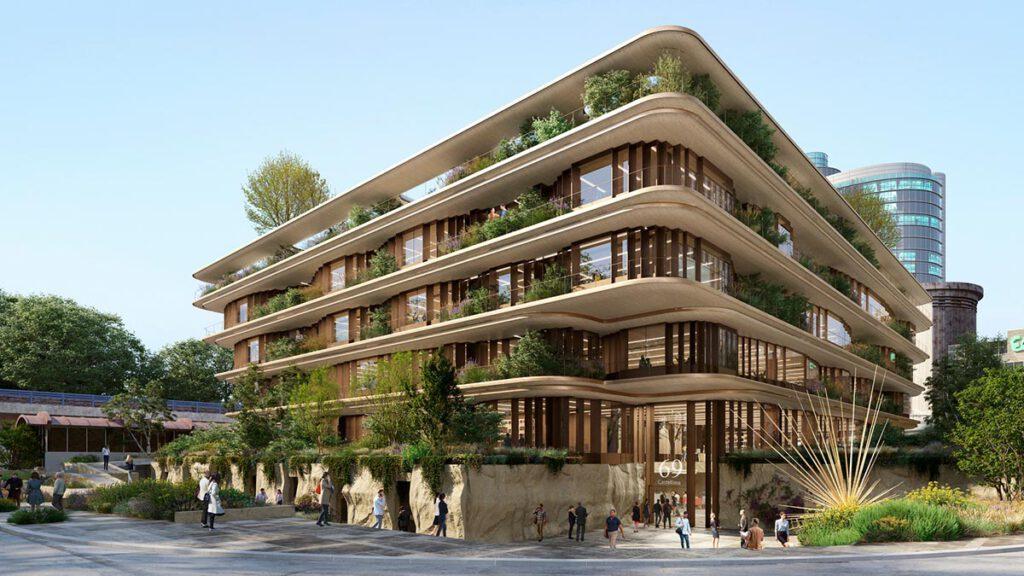
An office building is being constructed in Madrid that even does some work itself: generating solar power. More power than it actually needs.
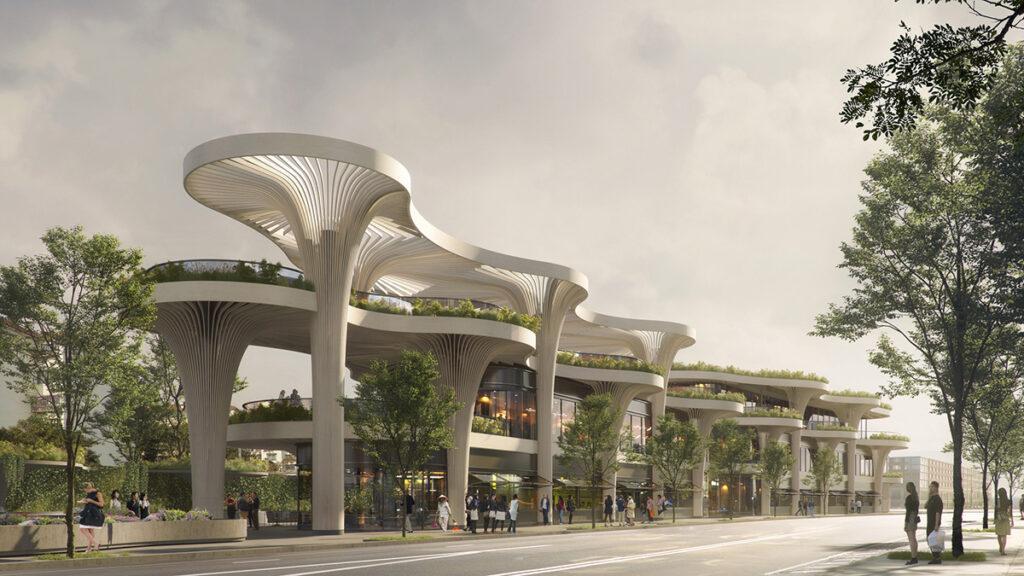
A woodland of man-made and native trees has sprung up in Shanghai, named Solar Trees Marketplace. It even generates its own solar power.
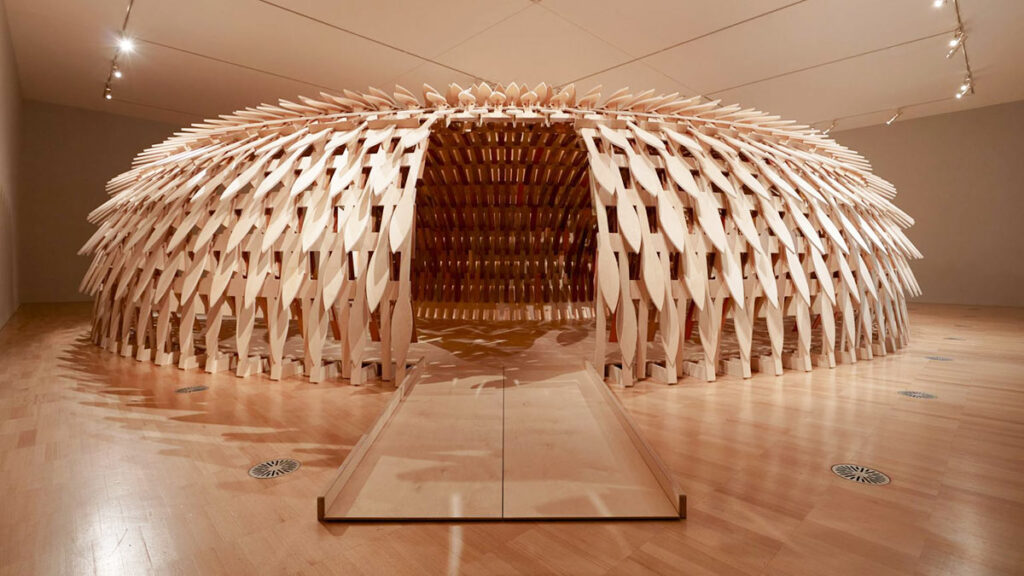
Japanese architect Kengo Kuma and Australian artist Geoff Nees teamed up to design the Botanical Pavilion – a wooden pavilion that is constructed like a 3D puzzle – without using any kind of glue or screws.
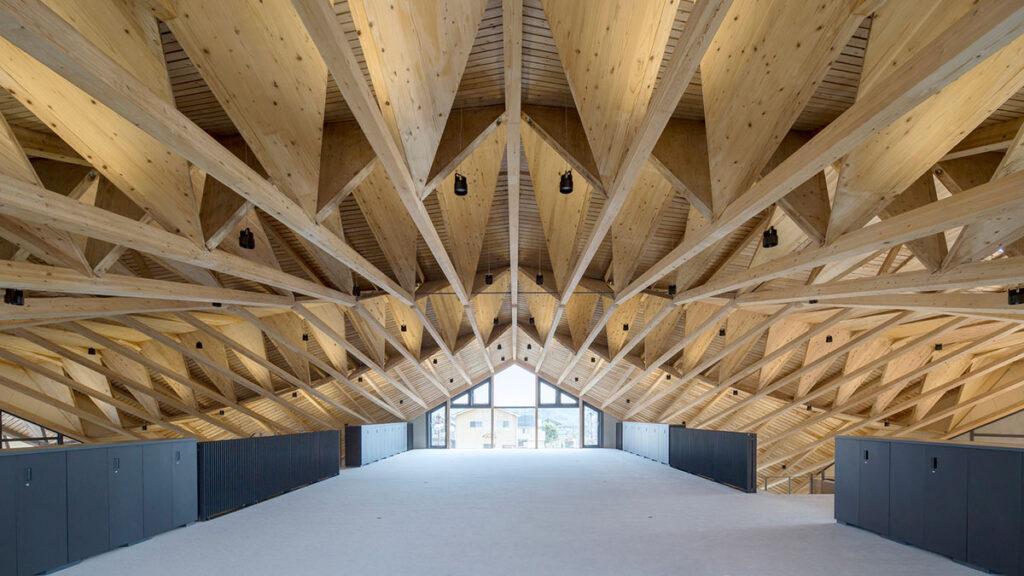
Japanese architectural firm UENOA has created a wooden office that has no need for bearing walls. Folded origami-style, the ceiling construction gives a whole new lightness to cross-laminated timber.
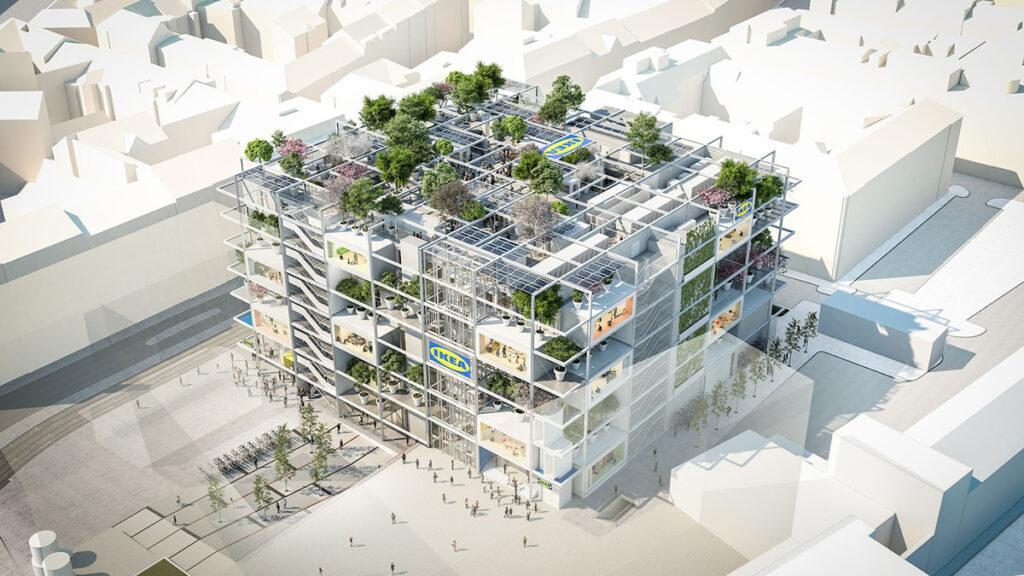
In 2021, IKEA will open its most innovative furniture store to date in Vienna. Designed by querkraft architects, the city store will bring cooling greenery to the Westbahnhof neighbourhood. For climate protection, against climate change – and GREENPASS Platinum-certified.
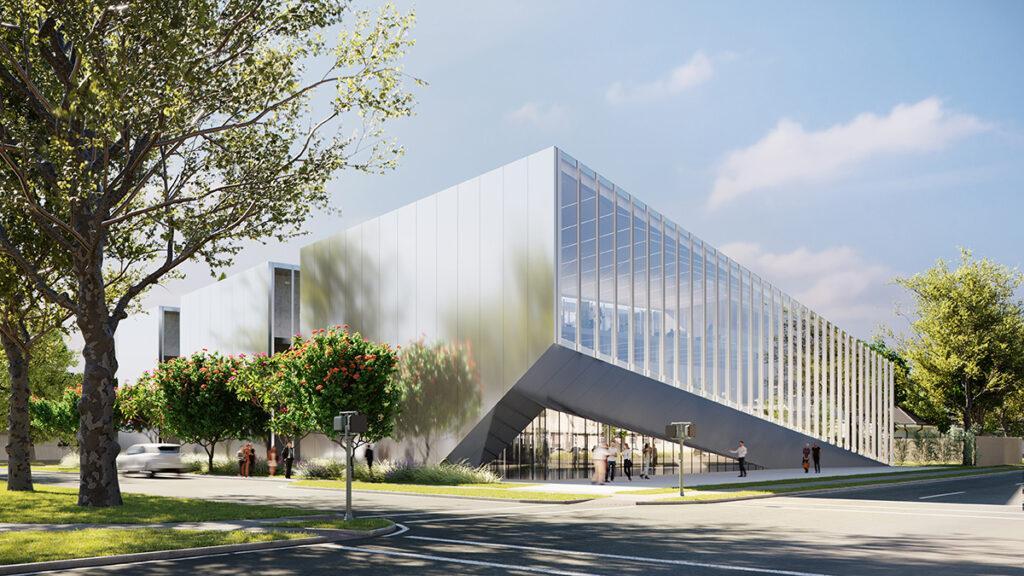
There is a new building taking shape in New Orleans that fits perfectly with two very pressing issues: the new Ochsner Center for Innovation will be devoted to developing modern healthcare solutions. The project, which has already won numerous awards, is geared wholly towards sustainability.
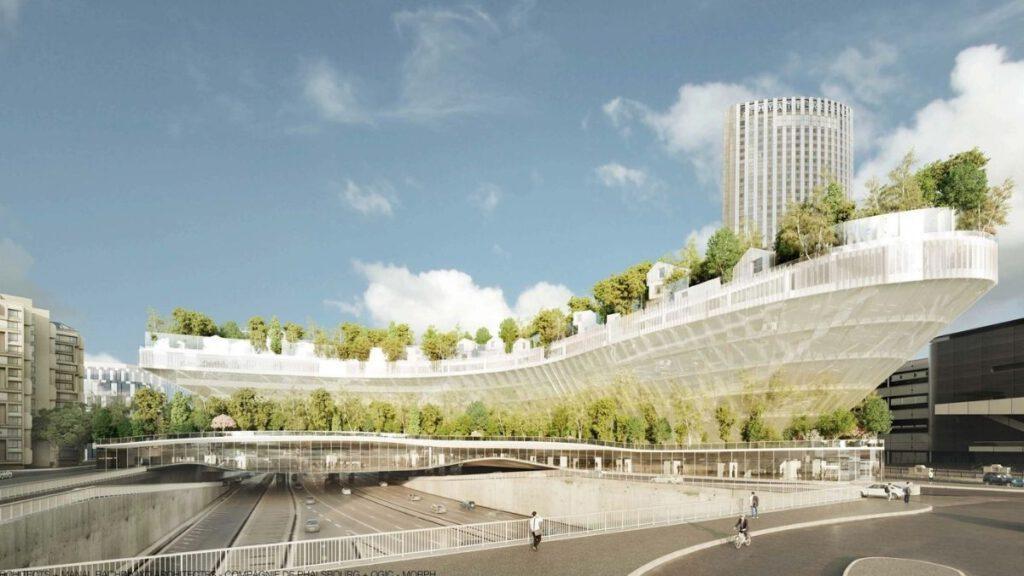
A good four years ago, OXO Architectes and Sou Fujimoto embarked on an adventure called Mille Arbres – a mega-project with a plant biotope over Paris’s famous Périphérique ring road.
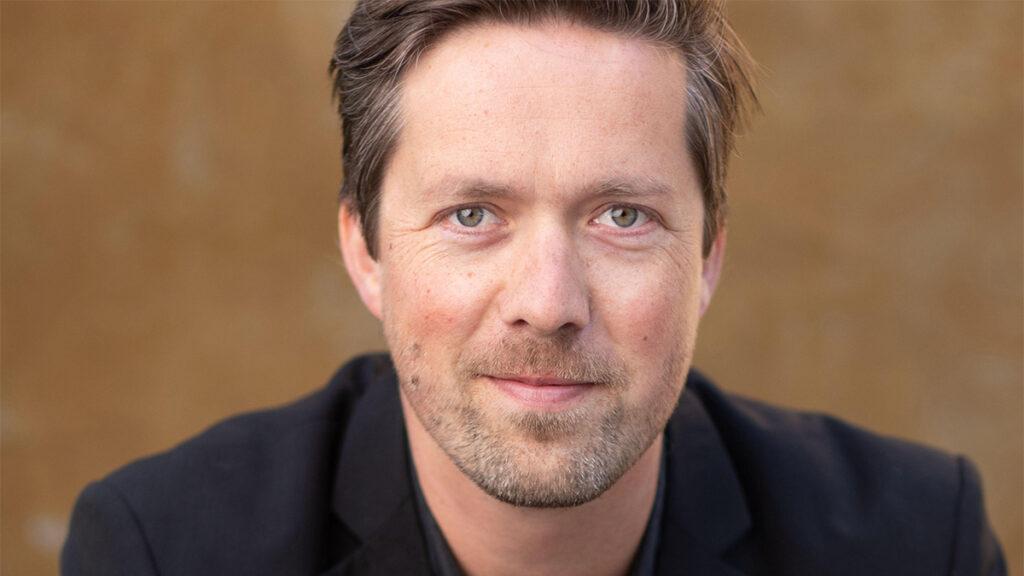
Sustainability is a top priority for the Powerhouse Company. In an interview, partner Stefan Prins explains why this means more than just a careful choice of materials and energy efficiency, and how essential it is to consider all the changes brought about by climate change when building.
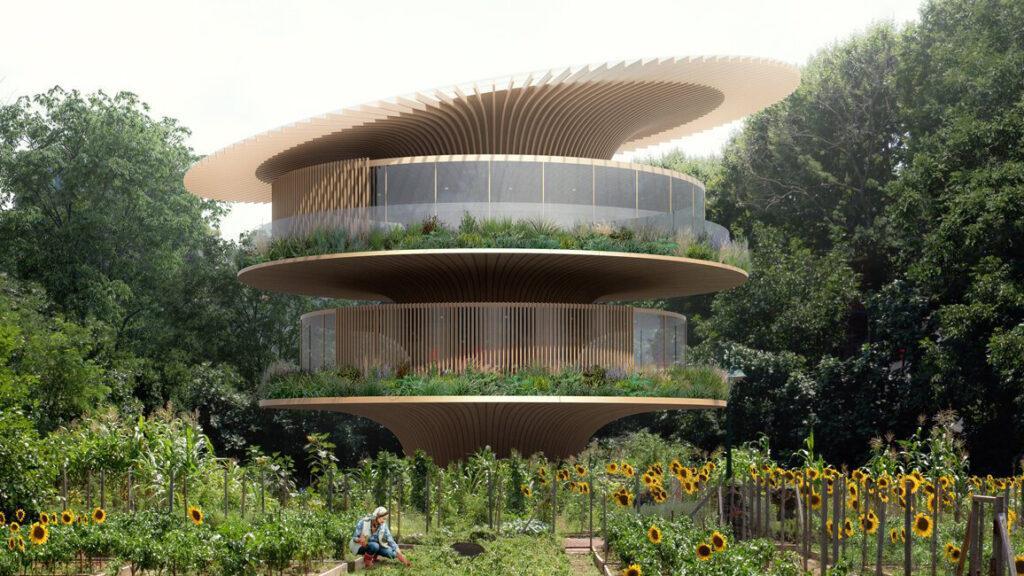
EU President Ursula von der Leyen wants to put climate neutrality centre stage. The first official related project is called Sunflower House and is based on the internal workings of sunflowers.
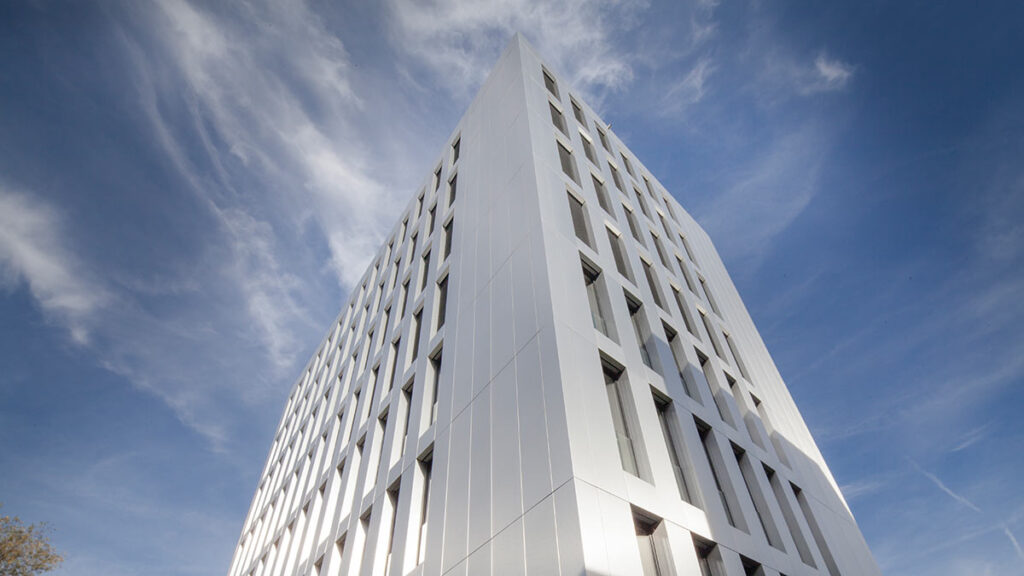
The Life Cycle Tower One was the first timber high-rise in Austria and the prototype for a new type of serial construction. CREE founder Hubert Rhomberg explains the green building concept and why we have to learn to think in lifecycles.
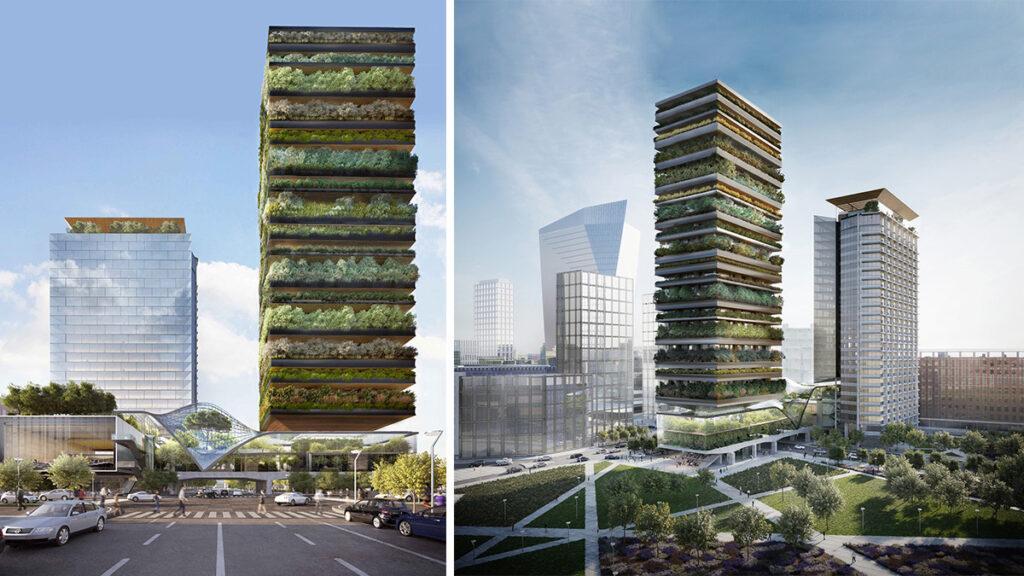
Milan’s iconic but disused Pirellino office building is to be renovated in spectacular style and renamed Pirelli 39. Its special greenery will even adapt its colours to the passing seasons…
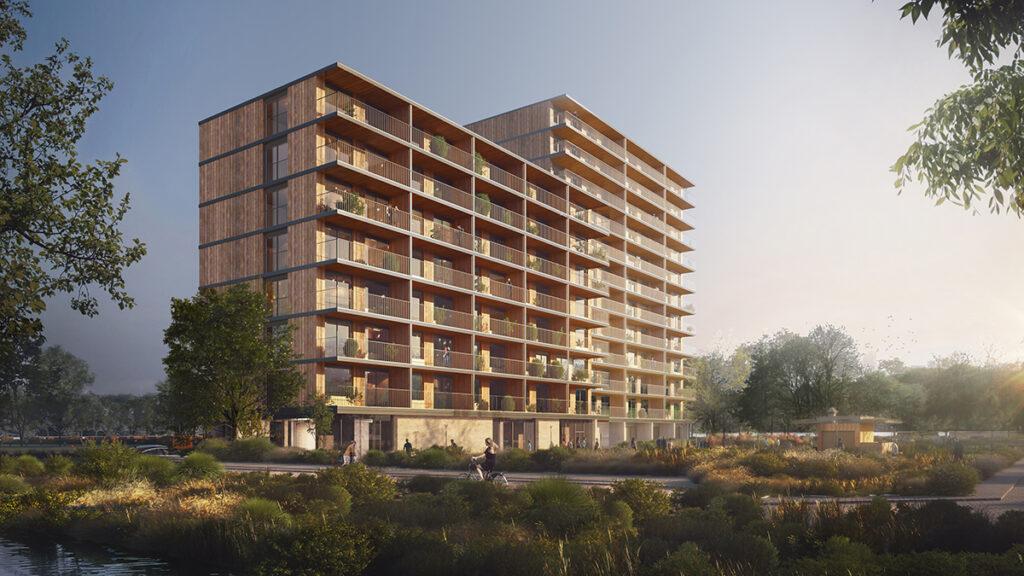
Most people looking for a new home with a sustainable design need to have deep pockets. Rotterdam’s Pendrecht district aims to buck this trend courtesy of timber building Valckensteyn, the brainchild of the architects at Powerhouse Company.
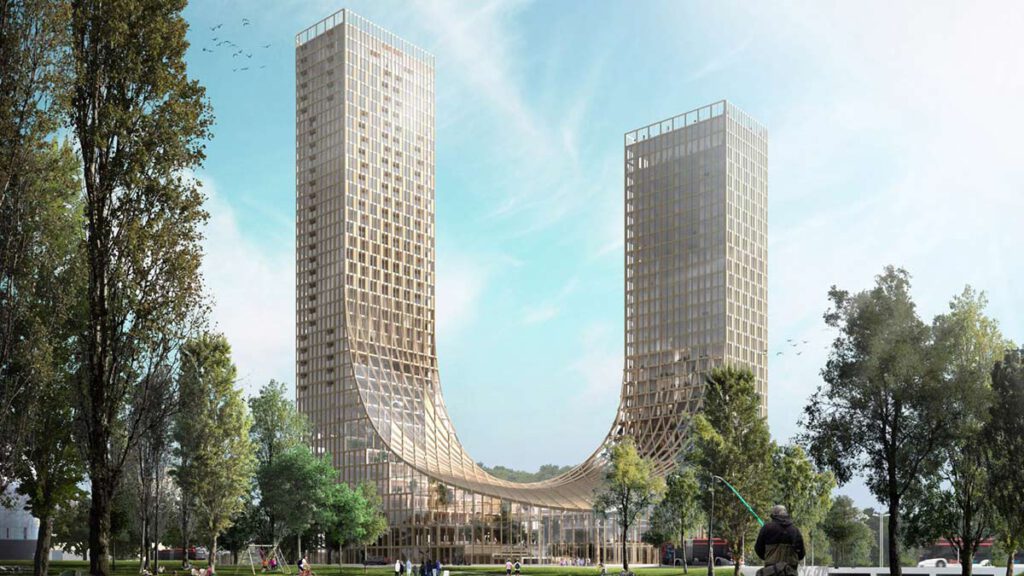
The Dutch city of Eindhoven will soon be home to the world’s highest “plyscraper”. The two towers – 100 and 130 metres high and known as the Dutch Mountains – are to set new standards in high-rise timber construction.
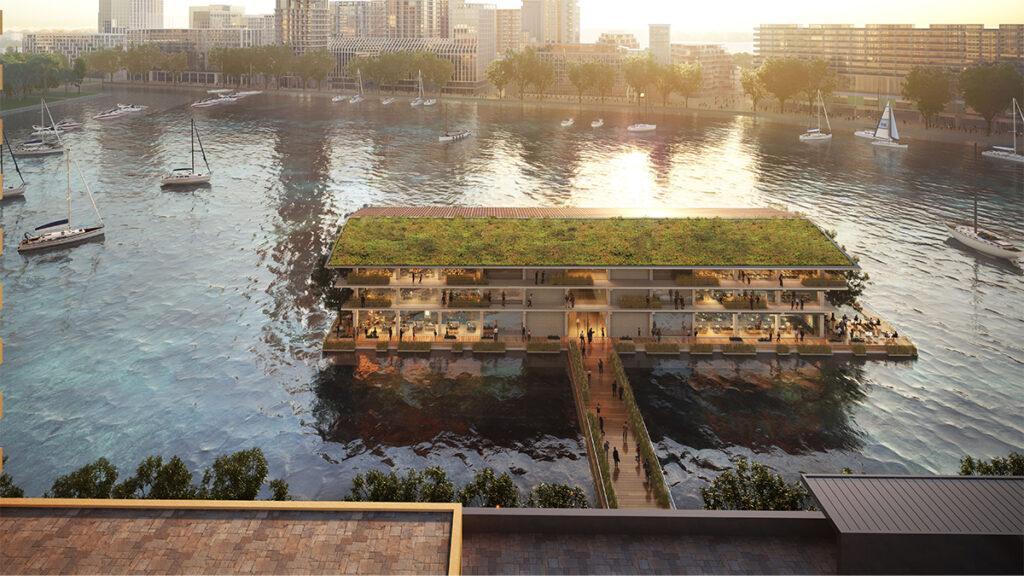
Workplace ahoy! Architecture studio Powerhouse Company has designed a concept for a floating office building. Sustainable, energy-neutral and made of wood, it will serve as the headquarters for the Global Center on Adaptation in Rotterdam as of autumn 2020.
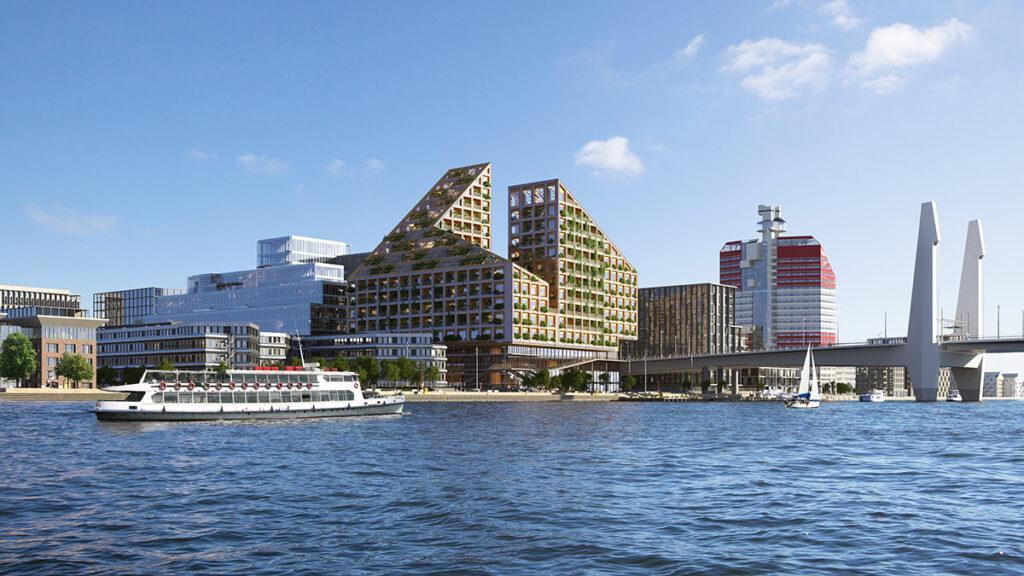
A mixed-use project in Sweden’s Gothenburg is being crowned by star architect Dorte Mandrup. The jewel in this crown is its use of timber. The new eco construction is intended to become an icon in sustainable urban architecture.
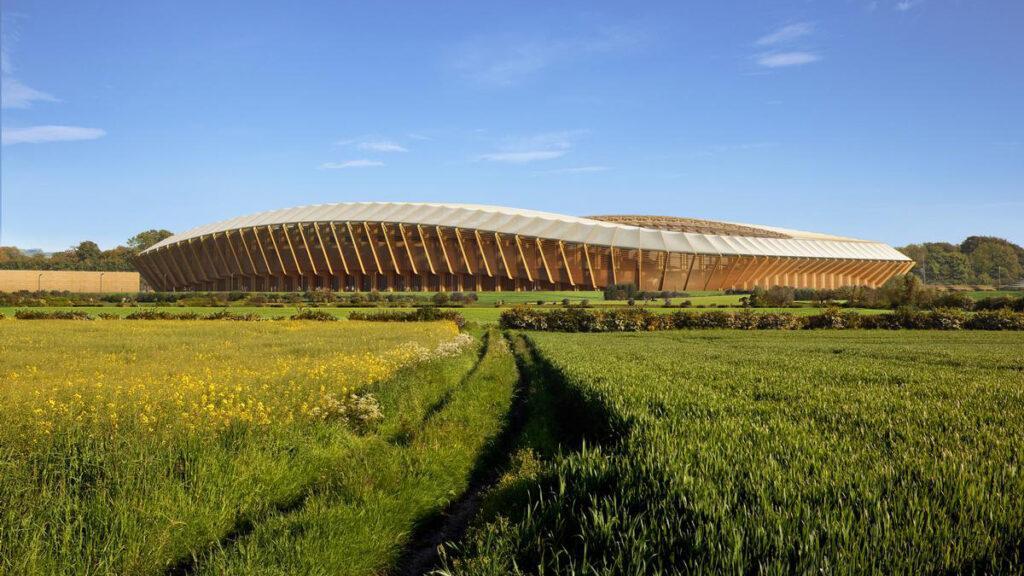
Following an initial defeat by the authorities, in the second leg Zaha Hadid Architects managed to gain planning permission for the world’s first timber football stadium.
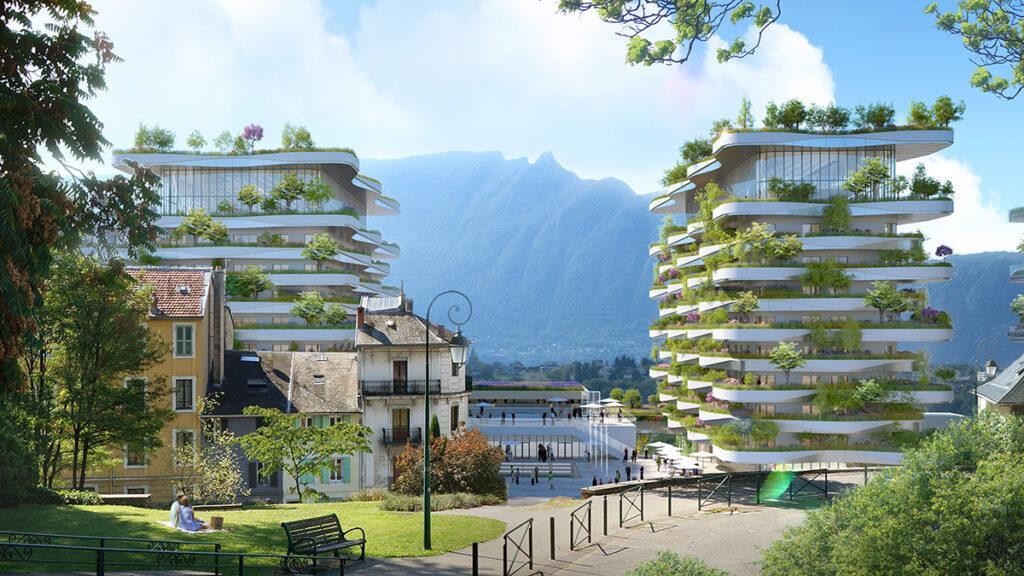
The ancient Romans used to bathe in healing waters here, and aristocrats from all over the world came to socialize during the Belle Époque. The historic baths in France’s thermal spa resort Aix-les-Bains are now on course for new fame: eco-architect Vincent Callebaut is turning them into a green paradise.
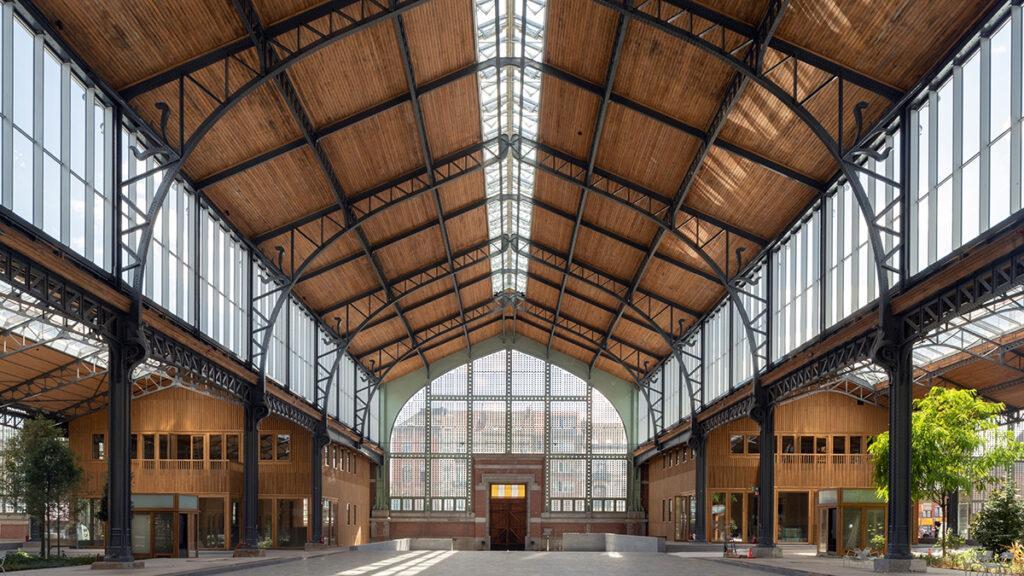
Once Europe’s largest freight station, Brussels’ monumental Gare Maritime is now the largest European CLT project. Neutelings Riedijk Architects have transformed the historic structure into a covered district, giving it a sustainable new lease of life using cross-laminated timber.
